John Podlaski's Blog, page 12
August 25, 2023
‘People Feel Expendable’—Military Could Lower Suicide Rate With Focus on Quality of Life
By ANNE MARSHALL-CHALMERS
Many of my readers have children in the military. This is an eye-opening report of the current conditions. It’s a lot different from when we served and combat doesn’t have to be the stresser to consider suicide. I think this is important enough for everybody to read and share.
Active-duty service members and veterans thinking of harming themselves can get free crisis care. Contact the Military Crisis Line at 988, then press 1, or access online chat by texting 838255.
In the summer of 2022, Craig Bryan, a psychologist, listened as a young service member explained why some days life didn’t seem worth living. The man in his early 20s didn’t point to combat-related trauma or the burden of physical injury. He felt depleted from his job in finance, specifically processing reimbursements for his fellow service members.
As Bryan recalls, the young man with dark hair, a thin frame, and a cautious way of speaking recounted how the software used by the Defense Department often resulted in errors or long delays. As a result, service members would come to his desk to yell about their lack of payment, and when he tried to correct the problems, the software would cause his computer to crash. Rebooting took 20 minutes, and it was not uncommon for the upset individual to complain to the man’s supervisor, who would later shout at him for poor performance.
The service member often stayed up working until midnight (only to oversleep for morning exercise, which resulted in more reprimanding) and said that when he thought about his future, he drifted into hopelessness.

Psychologist Craig Bryan speaks to a room of David Grant USAF Medical Center mental health care providers at Travis Air Force Base, California, in 2022. Bryan, a leading national expert on military suicide, taught advanced skills training for the providers during a two-day session. Photo by Lan Kim, courtesy of the U.S. Air Force.
“What’s the point of any of this?” Bryan recalls him saying. That triggered alarms in Bryan’s head. “When I heard that I was like, Holy shit, this kid’s at risk for suicide.”
Bryan didn’t think work stress alone might result in suicide. But the young service member appeared depressed. If he were to break up with a partner or lose a loved one, that would only push him closer toward risk. Easy access to a gun would multiply the risk further.
Another concern: his age. About half of the military suicides on Defense Department property involve people 25 years old or younger.
This young man was one of nearly 3,000 individuals across nine military installations interviewed for a report released earlier this year by the Suicide Prevention and Response Independent Review Committee, which formed at the direction of Congress under Secretary of Defense Lloyd Austin in the spring of 2022.
Bryan, who deployed to Iraq in 2009 as a psychologist in the Air Force and is a professor of psychiatry and behavioral health at Ohio State University, was one of 10 committee members who developed a 115-page report listing dozens of recommendations to improve service member well-being and reduce the persistent suicide problem. Since the 2001 launch of the war on terror, suicide rates have roughly doubled in the military.
After several months of talking with service members, their families, mental health providers, and others, Bryan started to view active-duty suicide as “death by a thousand paper cuts,” he says.
Those “paper cuts” range from a chronic shortage of behavioral health providers to a lack of computers for service members who must complete online training, delays in paychecks and reimbursements, and no air conditioning in sweltering barracks—complaints Bryan and his colleagues heard repeatedly.
“There were just barriers, I would say, to successful living,” says Rebecca K. Blais, a psychologist who served on the committee and says she was “struck” by the volume of daily stressors. Eliminating some of them, the committee argues, could help the mental state of service members, making them more resilient to whatever active duty throws at them. And while adding computers and improving housing may sound like an easy lift—especially considering the Defense Department’s $1.77 trillion budget—those familiar with how the military bureaucracy operates aren’t hopeful this report will result in significant, lasting change.

Graphic by Keith Pannell, courtesy of the U.S. Army.
“We know a lot about the problem—we know what we need to do,” says M. David Rudd, a psychology professor at the University of Memphis who has researched military suicide for more than three decades. “I think the probability is it won’t be done.”
Rudd blames the military mindset. The Defense Department should overhaul what defines “military readiness,” he says, calling it the most critical step in suicide prevention. Rather than evaluating command staff based on their training schedules, physical fitness scores, and marksmanship performance, he says, there should also be accountability for the mental fitness of the people in their units.
“Everybody views that as not related to military readiness,” he says, adding that military culture should shift to a more comprehensive view on military readiness that includes the toll of daily stressors, such as struggling to buy groceries. (A 2018 RAND Corporation report found that roughly 26% of active-duty service members are food insecure.) “If somebody can’t get paid, that impairs military readiness. You just don’t have people who think that way. That’s just not the way commanders think.”
And, many of the findings in the SPRIRC report aren’t new, Rudd says. Over the last 15 years, several reports across the services have detailed ways the Defense Department could tackle suicide—but the findings have so far failed to spark deep, sustained action.
“If the recommendations that have been repeatedly raised by multiple groups are not implemented, there is little reason to expect that suicides among military personnel will drop,” the SPRIRC report reads.
A plan to implement many of the SPRIRC’s recommendations is past the June due date set by Austin, but a Defense Department spokesperson says it’s coming.
‘Not Everyone Who Dies by Suicide Has a Mental Health Condition’Prior to the Sept. 11, 2001, attacks, civilian suicide rates were far higher than those in the military when comparing age groups. That flipped about five years into the wars in Iraq and Afghanistan, Rudd says. In 2021, a “Costs of War” research paper out of Brown University estimated nearly 32,000 active-duty personnel and veterans of the post-9/11 wars died by suicide—significantly more than the 7,057 service members killed during combat in that same time frame.

Military officials recommend reaching out to people who may be having difficulties and then helping them get to resources, such as the suicide helpline if they are at risk for suicide. Photo illustration by Joshua J. Seybert, courtesy of the U.S. Air Force.
Despite millions of dollars of DOD research on the topic, the problem lingers. In the first quarter of 2023, the Army recorded 49 suicides, compared to 37 in the same time frame in 2022—according to the DOD’s most recent quarterly suicide report. The Marine Corps also reported an increase.
Outside military installations, suicide in America has surged in the last two decades, particularly among teens and young adults. The demand for mental and behavioral health services far outpaces available providers, a challenge that the military and Veterans Affairs face, as well.
At many installations, service members have to wait four to six weeks between psychotherapy sessions, reducing treatment efficacy and prolonging symptoms, according to the SPRIRC committee. The report lists ways to remedy this—many of which have been issued in the past—including expediting hiring and eliminating budget and statutory limitations that hinder the Defense Department’s ability to increase pay.
But Blais says it’s important to recognize suicide as a complex tangle of factors.
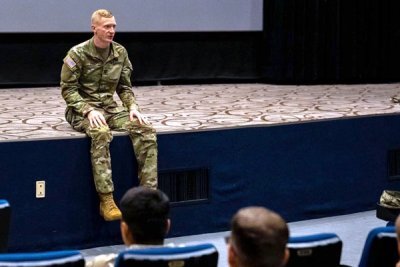
Capt. Anthony Priest, behavior health officer with 1st Signal Brigade, speaks with Company B, 304th Expeditionary Signal Battalion-Enhanced, in South Korea in 2022, about suicide. Photo courtesy of the U.S. Army.
“I think one of the conceptions that people often have is that people who die by suicide have a diagnosable mental health condition,” she says. “And that’s certainly not the case.”
Mental health can falter when everyday problems compound, and that can also trigger verbal abuse between service members and their families, Blais says.
“Military service members are trained to survive anything and with the fewest amount of resources possible,” she says. “That is part of what they need to be able to do. But what we were seeing on installations is that they were doing that day to day when it wasn’t required.”
When three junior sailors killed themselves in April 2022 while serving on the same aircraft carrier, investigators found daily stress contributed. They were assigned to the USS George Washington, a ship that was in a years-long “midlife overhaul” at Huntington Ingalls Industries-Newport News Shipbuilding in Virginia. A Navy investigation released in May found that thousands of sailors who have worked and lived on the ship since 2017 endured a poor quality of life, despite more than two dozen complaints to the inspector general between 2020 and 2022 addressing uninhabitable living conditions, safety violations, mistreatment of sailors on the basis of gender and sexual orientation, and the mishandling of sexual assault allegations.
While no direct correlation was found among the deaths of the three sailors, the report details the unpleasantness of daily life. For instance, sailors often parked miles away without enough parking at the shipyard and endured an up to two-hour commute by bus in traffic jams—a slog that drained morale.
Living quarters for the hundreds of sailors lodging on the ship were often without WiFi or reliable cell phone service—lifelines in modern society. The parents of one of the deceased soldiers told NPR that their son often tried to sleep in his car, or he would occasionally break rules and drive eight hours to visit home, only to return to the ship sleep-deprived and weary.
‘It Makes People Feel Expendable’Programs that boost morale, improve mental health, and decrease suicide rates do exist. The Defense Department’s own research has identified several effective therapies that help prevent suicide. But, “there’s no plan to roll them out” and embed them as staples of the Military Health System, Bryan says.
The Army’s Holistic Health and Fitness program shows promise. Early data reflects a 37% reduction in suicides between 2019 and 2022 in units that have implemented it, according to an article in Army Times. But the SPRIRC committee found it’s not unusual for such successes to operate in a silo or when leadership changes within units, the program to fade away.
More than a decade ago, a task force with the same charge as SPRIRC—which issued many of the same recommendations—highlighted the need for a “positive command climate” and leadership that’s held accountable for the entire well-being of service members, not just the physical aspect of health.

U.S. Navy sailors assigned to the aircraft carrier USS John C. Stennis distributed pamphlets to raise awareness for suicide prevention at the floating accommodation facility, in Newport News, Virginia, in 2021. Photo by Mass Communication Specialist 2nd Class Thomas Pittman, courtesy of the U.S. Navy.
Blais, the psychologist, says there’s evidence of a recent change in how leaders are selected in the Army. The Battalion Command Assessment Program focuses not only on physical and cognitive requirements for effective leadership, but also integrates assessment of written and verbal communication skills, feedback from peers and subordinates, and results of interviews with psychologists. She’d like to see all branches adopt that model, she says. As it is now, the promotion system rewards people who’ve been in the military a long time and may be good at the mission side of the armed forces, but not necessarily at the leadership required to keep service members healthy.
“One of the things that we heard, for example, is we would ask commanders, ‘How do you address your service members when someone dies by suicide?’” she says. “And it’s like, ‘Well, we don’t talk about it. We don’t want to draw attention to it.’ And it wasn’t malicious, but they’re just like, ‘If we tell people it’s going to happen, then it’s going to happen more.’ And as a psychologist, it’s like, ‘No, that makes people feel like they’re expendable and that they don’t matter.’”
‘We’re Not Saying People Shouldn’t Have Guns’While nearly two dozen recommendations ranked as the top priority, only a handful related to limiting access to guns drew heated debate online, including one that proposed prohibiting the sale of guns and ammunition to troops younger than 25 years old on Defense Department property.
When The New York Post reported on the proposal, readers derided a “woke” military and the violation of the Second Amendment.
Defense Department data indicates about 66% of active-duty suicides, 72% of reserve suicides, and 78% of National Guard suicides involve firearms. Citing a policy change that required Israeli military personnel to store their military-issued weapons in armories over the weekend and how that led to a 40% reduction in the Israeli military’s suicide rate, SPRIRC offered policy proposals that also attempt to limit access to personal guns.
When she helped to craft recommendations, Blais reviewed data that indicated it was not uncommon for men between the ages of 18 to 24 to have recently gone through a breakup, get drunk, and then tried to kill themselves.
If that gun is harder to reach for? “At the worst, they would have a really bad hangover the next day,” Blais says. “We’re not saying that people shouldn’t have guns. We’re just saying that we might want to be more thoughtful about where guns are, where they’re located, who has access to them, and where.”

Graphic by David Smith, courtesy of the U.S. Marine Corps.
Rudd likens the controversy to seat belts. Though the initial requirement of seatbelts ignited rally cries of lost freedom, eventually the federal government realized the safety benefits were too great to ignore. Since suicides are often hard to predict, he says, “steps to improve safety have a positive impact, just like seatbelts.”
The report also recommends screening for excessive alcohol use and displaying alcohol less prominently in military exchanges.
In March, the Defense Department announced a few of the SPRIRC’s recommendations would be adopted immediately as a task force worked through a more permanent, thorough plan. Those recommendations included expediting the hiring of behavioral health providers, screening for excessive alcohol use during primary care appointments, and improving the scheduling of behavioral health appointments.
In April, the Defense Health Agency began a pilot program that allows service members to book several behavioral health appointments at once—rather than having to schedule a follow-up after each visit—with the hope that the program will expand across the Military Health System, a Defense Department spokesperson tells The War Horse.
In an emailed statement, Sen. Kirsten Gillibrand, a Democrat from New York who serves on the Armed Services Committee, says she expects the Defense Department to take this report “seriously.” She’s pushed the military for years to ease career stressors and strengthen mental health services.
“I will be watching for real progress,” she says.
Bryan is watching too.
Though it’s been months since he sat in a conference room listening to that young, stressed-out service member, he finds himself thinking about him often.
He remembers the young man looked crumpled, exhausted—like someone under so much pressure, with such minimal relief, that he couldn’t picture his future as anything but grim.
“He is an exemplar of how institutional factors and quality of life matters are so important for understanding the emergence of suicidal thinking and suicidal behavior,” Bryan says.
This War Horse investigation was reported by Anne Marshall-Chalmers, edited by Kelly Kennedy, fact-checked by Jasper Lo, and copy-edited by Mitchell Hansen-Dewar. Headlines are by Abbie Bennett.
This article originally appeared on THE WARHORSE website on 8-24-2023. Here is the direct link:
*****
Thank you for taking the time to read this. Should you have a question or comment about this article, then scroll down to the comment section below to leave your response.
If you want to learn more about the Vietnam War and its Warriors, then subscribe to this blog and get notified by email or your feed reader every time a new story, picture, video and changes occur on this website – the button is located at the top right of this page.
I’ve also created a poll to help identify my website audience – before leaving, can you please click HERE and choose the one item that best describes you. Thank you in advance!
August 22, 2023
Lima Charlie Show Special
From Lima Charlie via LinkedIn
With school about to begin we thought it was a great idea to put together our first series of “Writer’s Block”! Please join us this Wednesday evening at 6 PM (est) on 105.3 FM, 1440 AM, or webrradio.com. You will hear from Sam Baker, John Podlaski, and Brian O’Hare; three of our nation’s finest authors who have all served in the military!
Below is John Podlaski. He is a Vietnam Veteran and a writer of several books. Please check out John’s website for further information: https://lnkd.in/gVHvGxSb
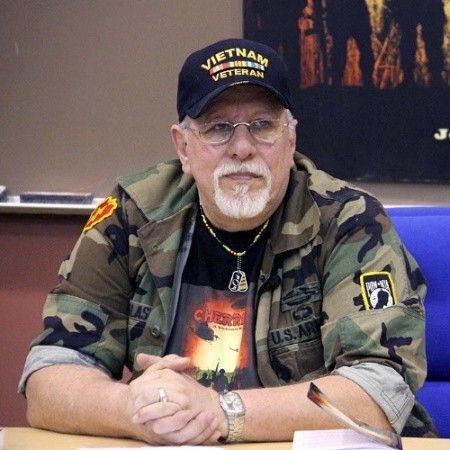
August 19, 2023
WHAT WAS THE CONCEPT BEHIND FIRE BASES IN VIETNAM?
A firebase in Vietnam, wherever in Vietnam, would be well-known to whoever habituated one anywhere. There were several thousand firebases during the conflict, manned by many units and many men, but they were all the same. Similar to the 19th-century fort concept, fire support bases in Vietnam could reinforce each other across long distances with powerful effects. Read the article to learn more about these firebases.
Vietnam was a non-linear war. There were no front lines with enemies on one side and friendlies on the other. Tactical problems could become very complex, with the enemy potentially in any or all directions. It was vital to be able to observe and fire 360 degrees all-around.
Although atypical of most 20th-century warfare, those conditions were not necessarily unique to military history. Perhaps the closest American experience was the Indian Wars of the 19th century—with isolated forts established to control certain areas and provide security to overland travel routes and civilian settlements in the sector.
One solution to the Vietnam War tactical problem was the fire support base (or firebase). Most 19th-century forts were isolated and had to be self-sufficient. Thanks to 20th-century technology, the firebases used by the allies in Vietnam could communicate with each other instantly and could be resupplied and reinforced by air.
WHAT WAS A FIREBASE?The fire support base was a combined infantry-artillery position that sometimes included armor. Depending on the planned duration of the position, firebases could be dug-in heavily and reinforced with engineer assets.

Perhaps the greatest strength of the firebases was their ability to cover each other with mutually supporting fires over great distances. It is a long-standing principle of firepower that massing fires is the most effective way to use artillery.
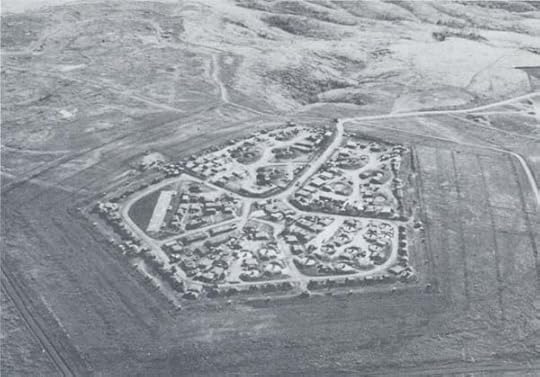
Through the 19th century, the only way to mass fires was to physically group the guns together on the ground. Between World Wars I and II, improved communications combined with innovative advances in fire direction control techniques made it possible to mass fires instantly on enemy targets from many widely-dispersed guns.
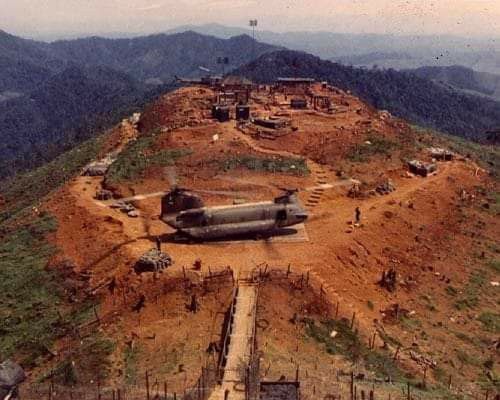
Firebases could reinforce the fires of their own internal guns with the guns of any or all other firebases within artillery range. It was a powerful multiplier effect.
 HOW WERE FIREBASES SET UP?
HOW WERE FIREBASES SET UP?The size, composition, and positional duration of a firebase depended on the planning factors of mission, enemy, terrain, and troop availability. Some firebases were very large and held positions for months or longer. Other firebases were relatively small and remained in position for days or weeks. A smaller firebase might consist of a company of infantry with a two-gun artillery platoon in the center of the position. A larger firebase might consist of two or three infantry companies, or possibly an entire battalion.
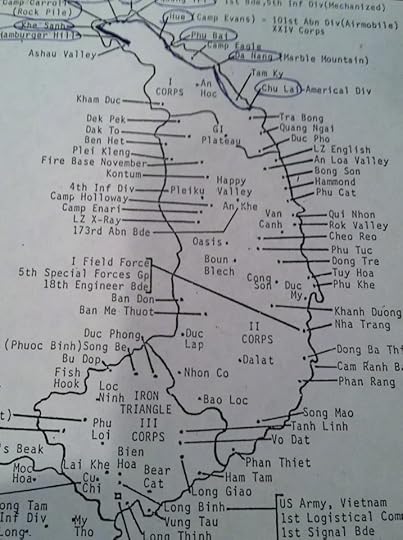
The artillery would consist of an entire six-gun battery. Instead of being positioned in the normal staggered line, the guns were deployed in a star position, with the base piece at the center and the other five guns forming the points of the star to provide rapid and effective fire in any direction. Smaller firebases with two or four howitzers deployed their guns when possible in square or triangle formations.
Firebases on flatter terrain were usually round, and those on ridges generally were rectangular due to terrain. Most larger firebases contained a helicopter landing pad for resupply and medical evacuation. When a firebase deployed forward, the guns often were moved by air.
FIREBASES USED IN ATTACK AND DEFENSEThe firebases were not merely passive defensive positions. Infantry patrols aggressively pushed out from the perimeter, day and night, but usually stayed within the guns’ maximum effective range fan—roughly 11,000 meters for 105mm howitzers and 14,000 meters for 155mm howitzers. When a patrol made contact, it could call for fire support not only from the guns of its own firebase but those of any other firebase in range.
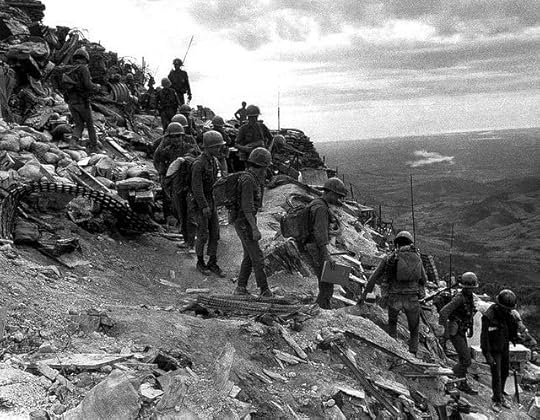
The firebases, of course, invited attack. One gun inside the firebase usually fired illumination rounds to deprive attackers of the cover of darkness. Other guns delivered fires where needed outward from the perimeter. Firing close to friendly troops could be complex because of the large bursting radius of HE ammunition. The solution to that problem was the M-546 Antipersonnel Round for the 105mm howitzer. Popularly called the “Beehive Round,” it fired 8,000 steel flechettes, triggered by a time fuze set to detonate just outside the perimeter. A green star cluster hand flare fired just before the Beehive warned troops on the perimeter to take cover.
Between 1961 and 1973, U.S. and allied forces established more than 8,000 fire support bases in Vietnam; only a small fraction existed at any given time.

Some of the war’s fiercest battles were fought over firebases, including Firebase Ripcord in Thua Thien Province (July 1-23, 1970); Firebase Mary Ann in Quang Tin Province (March 28, 1970); and Firebase Gold in Tay Ninh Province (March 21, 1967). Neither the VC nor the NVA ever managed to overrun a U.S. forces firebase.
For more information about the firebase battles mentioned above, go to the magnifying glass (search key) at the top of this page and type in the name of one of the firebases for a link to that article.
For more on firebases, please refer to another article on this website: https://cherrieswriter.com/2022/03/26/hill-of-angels/
This article originally appeared on History.net. Photos added by Admin. of this website. Here’s the direct link:
What Was the Concept Behind Fire Bases in Vietnam?
*****
Thank you for taking the time to read this. Should you have a question or comment about this article, then scroll down to the comment section below to leave your response.
If you want to learn more about the Vietnam War and its Warriors, then subscribe to this blog and get notified by email or your feed reader every time a new story, picture, video and changes occur on this website – the button is located at the top right of this page.
I’ve also created a poll to help identify my website audience – before leaving, can you please click HERE and choose the one item that best describes you. Thank you in advance!
August 12, 2023
I’ll Be Your Wingman
He should have been part of that flight. Instead, his best friend volunteered to take it and died along with two other pilots when their jets collided in mid-air. The author’s message in this article lifts others up in memory of lost comrades. Highly recommended. A read you should not miss.
by Dan Woodward
I Was a Pilot. They Were My Brothers. I Can Still Feel Them.
IMPACT minus 2 hours and 1 minuteYou could always identify the schedulers. They were the ones who ran from room to room attempting to fill flight sorties when instructor pilots had canceled for some reason or another. That morning was no different.
“Hey, Dan,” Tom said with a mix of hope and pleading in his voice, standing square in front of my desk waving a binder to emphasize the importance of the moment. “Could you help me fill a four-ship? The brief is in 27 minutes. My guest help just dropped.”
I looked up from my desk where I was completing paperwork from a student check ride.

A T-38 Talon four-ship formation flies over the Lamar Hunt U.S. Open Cup on July 27, 2022, in Sacramento, California. “It was a great jet nicknamed ‘The White Rocket.’ … But it was also unforgiving and unpredictable with the unprepared at the controls,” writes Dan Woodward. Photo by Senior Airman Frederick A. Brown, courtesy of the U.S. Air Force.
I liked Tom. Like almost everybody in the squadron, he was about 25 years old, lean, and newly married, with a lifetime of great dreams ahead of him. His hair was dark brown, accentuating dark brown eyes, an ever-present five o’clock shadow, and smooth olive skin.
Figuratively, we were brothers. Both Air Force instructor pilots flying advanced T-38 trainers. It was a great jet nicknamed “The White Rocket.” Very fast and able to bend a pretty sharp turn in blower, a term we used for the afterburners which added a real kick of thrust. But it was also unforgiving and unpredictable with the unprepared at the controls.
Tom flashed me a used-car salesman grin. I gave him a look that said “knock it off” and his smile grew quickly even.
“What the hell, Tom?” I asked. “Twenty-seven minutes to a four-ship brief?”
“I know,” he said, “but Maj. Ski just dropped. I gotta fill this sortie. Strong student.”
Ski had a reputation for doing this.
I knew the drill. I had been a scheduler as well, and this was my job and Tom knew it. I had the white space on my schedule, and he knew that, too.
“OK, Tom, OK. I’ll fill the seat. But, do me a favor, ask Tony, too. He’s a stick hog, and I really want to catch a workout over lunch.”
Tony sat next to me in this office. He really was a stick hog, meaning he would grab a flight every chance he got. He was also a good friend and a pilot training classmate of mine. We received our wings the same day.
Six-foot-two and around 200 pounds, he was a gregarious guy that you always felt was just a step away from giving you a bear hug that would crush you like a grape. Like Tom, Tony was my brother.
Tony was also finishing paperwork from a check ride, so Tom dutifully stepped to his desk and unloaded the same pleading request to Tony, adding something about me taking the sortie, if he could not. As expected, Tony the stick hog took the sortie, and Tom headed out the door after tapping my desk and saying he had it covered.
“Great,” I said.
It was the last time I would see Tom.
Twenty minutes later, Tony walked by my desk. He looked like he was on his way to benchpress a refrigerator. That’s how he always looked to me. It was the last time I would see Tony, too.
IMPACT minus one hour and 38 minutesAdditional paperwork complete, I popped up from my desk, grabbed my workout bag and headed through the length of the squadron. It smelled a little like a locker room and looked like a beehive, as students and instructors hurried in and out of flight rooms and the life support area where parachutes, helmets, masks, and G-suits—designed to keep you conscious when G-forces pushed the blood to your feet—were stored. The operations desk and flying supervisor had the usual 10 or so people ready to go, and a solid hundred sorties for the day were posted across a monstrous scheduling board in four-minute increments.
I walked past J Flight where Tom and Tony were briefing the four-ship. I didn’t give it a thought. I put one foot in front of the other.
I popped out the squadron door and headed for my car, walking past Tony’s giant, ancient Cadillac or Chrysler or whatever it was. All I knew was that it was old and enormous and sounded like an old man with bad knees when Tony fired it up. I hopped in my car and headed for the gym.
IMPACT minus 58 minutes“Heat check,” the student blurted into his mask-integrated microphone.
“Two, three, four,” came the response, indicating the formation was ready to taxi. You did not screw this part up. You sounded good and you looked good when you taxied in front of God and country and, most importantly, the other guys in your squadron. If you didn’t, everyone would shit on you.
“Heat 21 flight, cleared to taxi to runway 31 center, wind 330 at 10, altimeter 29.98,” ground control transmitted.
“Heat 21, 29.98,” came the student’s response.
About this time, I headed out of the gym after changing and started my usual run around the base. It would take around 40 minutes, then another 20 or so for a shower and quick slide back into my flight suit before heading to the squadron.
Everything was on track that day, until it was not.

“Why,” a statue dedicated in 1967 to service members, stands in front of the Placer County offices in Auburn, California, which Dan Woodward visits often. Photo courtesy of the author.
The formation executed an eight-second interval launch with lead accelerating to 300 knots, while the additional three jets accelerated to as much as 450 knots in blower to join the formation, with three-foot wingtip separation.
Another buddy of mine was lead for the moment, and he took the formation through the Pickwick departure corridor en route to the Pickwick military operating area. Leveling at 14,000 feet, the formation was cleared by Memphis Center for Pickwick high and low military operations, meaning the flight could use every foot from 8,000 to 23,000 feet.
They started to climb.
IMPACT minus 19 minutesAnything still could have changed at this point, but it didn’t.
I headed out of the gym, freshly showered and getting mentally ready for my late afternoon check flight. I pulled into the squadron parking lot and hopped out of my car, walking past a giant mural painted on the squadron exterior that said simply, “Lead, Follow, or Get Out of the Way.” We really did live that way.
Through the squadron doors, I returned to the beehive, walking the length of the building to my desk. There, I pulled out a bagged lunch from my side drawer and swallowed a peanut butter and jelly sandwich by practically unhinging my lower jaw from my upper jaw like a snake. After all, why waste time eating when all that did was get in the way of the mission? Lead, Follow, or Get Out of the Way.
I glanced at Tony’s desk. His flight jacket was draped over his chair. Plexiglass covered his desk and protected a dozen or so dollar bills presented by students following their first flight, and another dozen or so patches from student classes he had flown with. The lights flickered as they did from time to time, and in that chair, for an instant my gregarious brother sat, and then he was gone.
IMPACTPhysics is a profoundly unforgiving mistress. For every action there is a reaction. Military aviation marries you to this reality and all others in the natural world. Tony knew this. We all did. But it didn’t make things easier when physics turned on you.
He pitched up and pulled right and then down to the buffet, where the jet told him he was demanding all it had. As number three in the four-ship, he was responsible for taking his aircraft and the number four aircraft back to the lead element, solving the complicated geometry of closing two jets on another two jets at 400 knots as they maneuvered 4,000 feet away.
This was a tactical rejoin, a basic building block in creating a combat aviator. Spread wide to facilitate clearing and radar coverage for enemy jets in the future, flight lead had decided to bring the formation back to three-foot wingtip separation to practice other skills.
Crossing behind lead at nearly 500 knots, Tony pitched to the outside of the turn, and, needing additional closure to expeditiously join, he reversed and pulled hard back to the inside.
His wingman, the number four aircraft in the formation, could not respond quickly enough and pulled to match Tony’s pull too late to clear the flight path. Both aircraft exploded on impact, with Tony’s jet smashing his wingman into unrecognizable debris behind the front cockpit. Tony, Tom, and Will, Tony’s student, touched the hand of God, and chaos brutally shoved itself into the lives of everyone they knew.
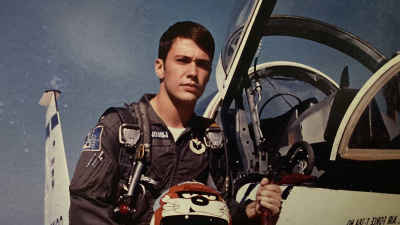
Dan Woodward pictured near the end of his pilot training. One of his classmates, Tony, would later die in a T-38 trainer crash. Photo courtesy of the author.
This story goes on, but last night I asked Tony to help me with clarity and brevity, so he took my pen. Did I mention he was a stick hog?
I sat at my desk and the lights flickered. I looked at my friend Dan. He had just eaten a peanut butter and jelly sandwich and was wondering what was going on as the squadron went into lockdown.
I would not be back, but I would always be around. Dan would always remember me, and Tom and Will too. He was our brother. I would never tell him that, but he knew it.
He would meet my mom, pack my clothes, meticulously build my service dress, pay my bills, place a new medal on my uniform, and drive my car home for the last time. I would not thank him, but he knew I would if I could.
Someday when the leaves were changing in his life, and the time was right with brothers and sisters he knew forever but met only briefly, a question long buried would come to the surface.
Why? Why them and not me? Why that day? Why that way?
Here is what I told him.
You were not to blame. You could not know what rested in the future, and in the future, you must not dwell on the pain of the past.
You can disrupt the ripples in a pond, but you cannot stop them. Be at peace with it. I am. I took the flight. You did not give it to me.
Your life gives value to mine. You lived on for a reason, and I want nothing more than to see that reason fulfilled.
When you walked by J Flight, you put one foot in front of the other. Keep doing that.
For every action there is a reaction. React toward the light and away from the dark. I do not need you closer to me. Not yet.
My friend, lift up those around you. Inspire them. Speak for me. Act for me. Laugh for me. But do not cry for me. There is no time for that, because you never know when you too will touch the hand of God.
I got up from my desk and walked over to Dan. He sat there still confused by the commotion of the moment unfolding around him. I gave him a hug and crushed him like a grape. I always wanted to do that. He would be fine.
The lights flickered, and I was gone. But always around.
IMPACT plus one secondTumbling end over end, the remaining intact portion of the number four aircraft plummeted toward earth with Vince strapped to his ejection seat. He pulled the ejection seat handgrips and the rocket shot him clear of the wreckage, but the seat was damaged on impact and failed to automatically deploy his chute. He was fighting physics to the death, tumbling and spinning like a top; earth and sky blended together in a whirlwind of terror. After 17,000 feet in free fall, Vince managed to break free of the seat and got a full chute 400 feet above the ground. Physics had toyed with him.
The lead two ships transitioned to a highly maneuverable chase formation and descended slowly, careful to remain well clear of any falling wreckage. The senior instructor transmitted details back to the operations supervisor, triggering the implementation of a mountain of checklists. Support aircraft were launched with full fuel loads, and would rotate on station over the crash site for as long as daylight permitted.
Three were lost, one miracle was found, and the remaining four in the formation were changed forever.
IMPACT plus 48 hoursThe parking lot was empty, except for Tony’s car. Sunday morning was always quiet. I parked nearby and carried a cardboard box into the squadron. I had a key.
There were ghosts here. I could feel them. My brothers.
I walked into my flight room and over to Tony’s desk. You could not think about an act like this. You just did it.
I pulled the plexiglass off his desk and collected his patches and dollars and a few other things. I took his flight jacket from the chair and dropped it into the box. I sat at his desk, violating every possible measure of privacy, opening drawers and dropping their contents onto his jacket. I paused at a picture of him receiving his wings. For good luck, tradition held that they would be broken by the recipient, that day. I wondered if he had done that.
This was my job. I was Tony’s summary court officer, under orders to account for everything: pay his bills, resolve his issues, and serve as the Air Force representative to his mom and family. I would do this job perfectly. I owed it to Tony. Lead, Follow, or Get Out of the Way.
I left the squadron and its ghosts as I found it, quiet, reflective, and alone, and went to Tony’s car. I had located his keys the day I was placed on orders, and I opened the door, tossed the box onto the passenger’s seat, and fired it up. True to form, it sounded like an old man with bad knees.
I drove the car from the squadron for the last time.
IMPACT plus 96 hoursTony’s dress blue uniform was back from the cleaners. Everything except his wings would be new. Those would stay.
I measured everything. “That looks about right” would not work here. It took 10 minutes for each “U.S.” lapel insignia as I moved the two needle-like pins back and forth with barely a thread’s difference and lined everything up perfectly with a ruler. Someone else could do this as well. I didn’t care. This was my job.
The extent to which I had violated every measure of his privacy was now nearly complete. His lease was broken and paid, his electric and trash bills paid, his laundry washed and cleaned. The packers were scheduled for one week from Friday. We would ship his car.
I met his mom in Tony’s home. I wore my flight suit and my black-and-gold squadron neck scarf. She liked the scarf and I made certain there would be one in Tony’s shipment. We walked the place largely in silence, and she gave occasional instructions about shipping his things. I took mental notes.
That day, I received a small plastic bag with the items Tony had with him when physics severed his dreams from reality. I cried alone. If you really had to cry, you did it alone. I was a man and a pilot. Lead, Follow, or Get Out of the Way.
IMPACT plus 5 daysThe memorial service was held in the base chapel. Three were lost, one miracle survived, and thousands more lives were changed forever. I sat in one of the last pews and listened to every word. I prayed when I was told. This would help with closure for some, and for others, it would push things deep inside where they might never emerge. Or maybe they would.
IMPACT plus 61 yearsI love this place. Sequestered in the Adirondack Mountains of middle New York, the tranquility is cathartic and deep. The leaves are changing and falling at the same time, leaving a patchwork quilt of red, amber, and gold on brilliant green lawns and on the limbs above. This place is old, like me, with mountains worn smooth and gentle from years of battles with the forces of nature. The woods are deep and the trails inviting, with overgrown and hanging limbs often forming arches of natural magnificence.

In the mornings, I wander these trails, eventually returning to be with friends who years before I had met in this place to talk about lives of service. These talks often exposed life’s five great emotional conflicts: life versus death, living versus dying, truth versus deception, love versus hate, and peace versus war.
Within all these talks, my friends helped bring me the answer to the question of “why.” Why them and not me? Why that day? Why that way?
Among my friends were the poet, the artist, the journalist, the warrior, the scientist, the quiet, the conflicted, the wounded, the scarred, and the searching. I was in the last of this group, but like most, I dabbled in them all from time to time.
This morning, I awake early and set out on a path that is new to me. I travel alone. This path seems to insist on it.
Pausing at a pond, smooth and calm in the gentle breeze, I toss a stone into the depths. The ripples take their own course, and can never be stopped.
Crossing a small stream, I walk up a gentle slope into a narrow arched cathedral of a trail. Sunbeams flicker as I walk under the canopy of leaves, shuffled by the gentle breeze.
In the woods are a lifetime of memories: My mom takes with joy a bouquet of dying dandelions, and my dad takes my first pitch. My brothers and sister bring me confidence and my soul mate brings me purpose. Her huge brown eyes gleam with love and I stop for a moment and take her hand.
I had commissioned her into the service and retired her as a general. All points in between had been a blessing. We shared hopes and dreams and fulfilled most. The photos of our life were photos of inseparable love, and our “selfies” through the years showed growing lines on our faces that favored the smile over the pained. I was grateful for that. Every day a gift; all of life a wonder. How fortunate I had been.
I cup a falling tear from her and place it in my pocket. “One foot in front of the other,” I whisper.
There too, are decades of brothers and sisters who served with me in war and peace and who were everything in life. Among them is my gregarious Tony.
I step toward him to give him a hug. “Get away or I will crush you like a grape,” he says.
“Message received,” I say. “What are you doing here, Tony?”
“Waiting for you. It took you long enough.”
“Sorry,” I say. “If I had known you were waiting, I would have hurried things along.”
“Would not have wanted that,” he says emphatically. “You set your own pace. That was the right thing to do.” He pauses. “Do you remember what I told you that day?”
I know exactly what he is referring to. That day in the Adirondack Mountains when I struggled to find the words to finish my story—our story.
I say, “Like it was yesterday.
“You said I wasn’t to blame, and that I shouldn’t dwell on the past. You said that you took the mission, that I didn’t give it to you. You asked me to make the most of the life I’d been given, and to keep putting one foot in front of the other. Then you asked me to lift up those around me, and to inspire them, and to speak for you, act for you, and laugh for you.
“My life’s been great, Tony. I did the best I could. I wish I could have shared it with you.”
“Ripples in a pond,” he says. “I am at peace with it.”
“You did better than most and not as good as some. You dwelled on the pain of the past, but it was deep. You were at peace, but it was still inside you. You gave value to my life and you put one foot in front of the other. You stayed in the light, and my friend, most importantly, you lifted up those around you and inspired them; and you spoke, acted, and laughed for me. I also felt the tears. I wished they weren’t there, but I understood when they came. I missed you, brother.”
“Ripples in a pond,” I reply.
He nods.
“Lead, Follow, or Get Out of the Way,” he says. “I’ll take lead.”
“Right. OK, I’ll be your wingman.”
He turns and quietly calls over his shoulder, “Heat check.”
“Two,” I respond.
He starts up the hill. A gentle breeze shuffles the leaves and the sunbeams flicker, and I am gone. But always around.
Editors Note: This article first appeared on The War Horse in April 2023, an award-winning nonprofit news organization educating the public on military service. Subscribe to their newsletter[image error]
*****
Thank you for taking the time to read this. Should you have a question or comment about this article, then scroll down to the comment section below to leave your response.
If you want to learn more about the Vietnam War and its Warriors, then subscribe to this blog and get notified by email or your feed reader every time a new story, picture, video and changes occur on this website – the button is located at the top right of this page.
I’ve also created a poll to help identify my website audience – before leaving, can you please click HERE and choose the one item that best describes you. Thank you in advance!
August 5, 2023
A FIGHT TO REMEMBER: THE 4TH INFANTRY DIVISION AT DAK TO
The legendary elite units, often the focus of battle tales popular with the public, are not the only ones that make vital contributions in combat—as the battle of Dak To shows. The 4th Infantry Division, although often overlooked, made key contributions during that battle. Read more about their involvement:
By DANA BENNER
In accounts of the November 1967 battle of Dak To, one of the largest and longest battles of the Vietnam War, the center of attention is often the elite 503rd Infantry Regiment (Airborne) of the 173rd Airborne Brigade, assigned prior to the battle to the 4th Infantry Division. Seemingly forgotten is the fight waged by the division’s “leg” (non-airborne infantry), engineer, and artillery units.
That’s a sore spot for some veterans who were at Dak To.
“The 173rd were good soldiers and they did their fair share; they certainly did no more than the many other ‘non-elites’ did, like the 4th Division grunts, the artillery and others,” said Steve Stark, an artillery liaison specialist assigned to the 6th Battalion, 29th Field Artillery Regiment, 1st Brigade, at Dak To, in an article by Tim Dyhouse for VFW Magazine.
The 4th Infantry Division—nicknamed the Ivy Division for the pronunciation of the unit’s number in Roman numerals, IV—was led by Maj. Gen. William Peers. It comprised the 1st, 2nd (Mechanized) and 3rd battalions, 8th Infantry Regiment, commanded by Lt. Col. Glen Belnap, and the 1st and 3rd battalions, 12th Infantry Regiment, under Lt. Col. John Vollmer. Supporting the missions at Dak To were 15 artillery batteries in the division.

The battle was a collection of fights waged simultaneously against the North Vietnamese Army and Viet Cong from Nov. 3 to Nov. 23 on several hills near the Central Highlands town of Dak To in Kontum province, close to the point where the borders of Laos, Cambodia and South Vietnam meet. In the most high-profile fight, the 173rd Airborne battled for control of Hill 875. However, units of the 4th Infantry Division were the first to make contact with the enemy when they fought the NVA on Nov. 3 and 4 around Hill 1338. (Hills were numbered based on their height in meters.)
The Dak To area, with its thick jungle and steep mountain ridges, was a particularly hellish location for a battle. Tangled thickets of vines and thorns lay in the valleys between the ridges—all of them full of snakes, leeches and enemy fighters.
Within this tangled mess, the North Vietnamese had established a base camp, designated Base Area 609, linked by the Ho Chi Minh Trail to a command center in Hanoi. Countering the communist presence in the area were camps where small contingents of U.S. Special Forces, the Green Berets, trained and assisted militias of local hill tribes organized as Civilian Irregular Defense Groups. These CIDG camps were constantly attacked by NVA and Viet Cong forces.
The 4th Infantry Division had overall command of Kontum province and Pleiku province to the south as well as the northern portion of Darlac, the province below Pleiku. Spread over such a large territory, the division could send to Kontum province only one mechanized battalion (a unit that transports infantry to the battlefield in armored tracked vehicles): the 2nd Battalion, 8th Infantry (Mechanized).
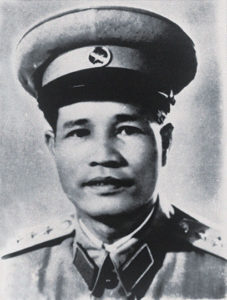 Communist Gen. Nguyen Chi Thanh developed the strategy used by the North Vietnamese at Dak To. / Alamy
Communist Gen. Nguyen Chi Thanh developed the strategy used by the North Vietnamese at Dak To. / AlamyTo get to Dak To from Pleiku city, U.S. troops followed Route 14 north through Kontum city and then turned west on Route 512.
“North of Dak To, Route 14 rapidly deteriorated as it approached a CIDG camp at Dak Seang,” wrote Allay Sandstrum in “Three Companies at Dak To,” a chapter in Seven Firefights in Vietnam.
“Still farther to the north, the road became so poor that another camp at Dak Pak had to rely solely on an aerial lifeline.”
The NVA’s objective was simple: Sweep all American forces and Army of the Republic of Vietnam troops from the Central Highlands. If the North Vietnamese succeeded, they would have a clear path into South Vietnam for attacks on cities and U.S.-ARVN military installations as part of a planned Tet Offensive in early 1968 that the communists hoped would deliver devastating blows all across the country.
Under a strategy developed by Gen. Nguyen Chi Thanh, the NVA would first isolate and destroy brigade-size or smaller American units positioned at or near Dak To. Those engagements, Thanh believed, would slowly drain the strength of U.S. forces and compel American commanders to send in reinforcements from other areas, thus weakening the defenses in the locations they left and creating more openings for communist troops during the Tet Offensive.
To implement that strategy, the NVA planned to deploy its 24th, 32nd, 66th and 174th regiments from the NVA 1st Division, a total of about 6,000 men. Those units would use “hit and run” tactics, basically running in from Cambodia and Laos to do as much damage as possible and then retreat back across the border, out of range of American firepower.
The North Vietnamese forces were under the overall command of Maj. Gen. Hoang Minh Thao and political officer Col. Tran The Mon.

By the end of October 1967, bits and pieces of information trickling into U.S. officials from the CIDG camps and reconnaissance patrols indicated the communists were preparing for something. Intelligence sources revealed that the NVA’s 1st Division was moving the bulk of its forces from the Cambodian border and remote locations in the Central Highlands toward Kontum province. This large-scale transfer of troops forced the Americans to counter the NVA’s move, like playing a deadly game of chess.
On Oct. 28, the 4th Infantry Division replaced its mechanized battalion with the 3rd Battalion, 12th Infantry Regiment, using foot soldiers to more effectively locate the enemy. Long-range reconnaissance patrols reported enemy movement toward Dak To from the southwest.
The 1st Brigade, 4th Infantry Division, commanded by Col. Richard Johnson, moved its headquarters to Dak To, closer to the action, and brought in the 3rd Battalion, 8th Infantry Regiment, to strengthen its forces. The recon teams, with the aid of airborne surveillance devices, kept track of enemy movements and spotted recently established base camps loaded up with ammunition caches.
Lt. Gen. William Rosson, commanding general of U.S. forces in the central South Vietnam region, called in the airborne troops of the 4th Battalion, 503rd Infantry, airlifting the men to Dak To from Phu Yen province on the coast. That boosted U.S. strength to three battalions totaling around 4,500 men as of Nov. 1.

As American combat units moved into place, the 4th Infantry Division also brought in Company D, 704th Maintenance Battalion; Company B, 4th Medical Battalion; 1st Platoon, 4th Military Police Company; communications personnel from the 124th Signal Battalion and an attached engineer platoon from the 299th Engineer Battalion. All of the elements for sustained combat were in place. The only thing missing was up-to-date intelligence on enemy activities.
Good fortune shone upon U.S. forces when a North Vietnamese sergeant in the 66th Regiment, Vu Hong, surrendered in the village of Bak Ri, near Route 512, north of Dak To. Hong said his 50-man unit had been selecting firing positions for mortars and 122 mm rocket launchers. He also said five regiments were converging on Dak To and the CIDG camp at Ben Het, just west of Dak To.

The plan, as Hong relayed it, called for a southwest to northeast attack. The NVA 32nd and 66th regiments, with the support of the NVA 40th Artillery Regiment, were to spearhead the assault. The NVA 66th Regiment was southwest of Dak To, and the 32nd Regiment moved from the southwest to Dak To to prevent an American counterattack that could come from the base. The NVA 24th Regiment would set up northeast of Dak To, in Tan Canh, and act as a blocking force to prevent American forces from escaping. The 174th Regiment was to stand by as a reserve unit.
With the new intelligence in hand, Lt. Col. James Johnson, commander of the 4th Battalion, 503rd Infantry, ordered his men to set up a firebase at the Ben Het CIDG camp. The NVA, perhaps surprised by the fast response of U.S. forces, pulled back to defensive positions and waited. The NVA 66th Regiment moved to high ground southwest of Ben Het. Johnson, seeing an opportunity to stop the NVA in its tracks, moved the 503rd Infantry to meet the enemy. Holding the high ground, the North Vietnamese waited.
At the same time Belnap, the commander of the 3rd Battalion, 8th Infantry, sent companies B and C to the southwest, and Vollmer, leading the 3rd Battalion, 12th Infantry, deployed his A and B companies, which were airlifted to Ngok Ring Rua Mountain south of Dak To. The 12th Infantry Battalion would set up a firebase, and the 8th Infantry Battalion was to establish a position along the trail to the Dak Hodrain River Valley and stop the flow of enemy traffic to that area.

The Americans intended to launch an offensive strike on the North Vietnamese before the enemy troops could fully dig in for their offensive. Units of the two 4th Infantry Division battalions initiated contact, in separate encounters, with troops of the NVA 32nd Regiment on Nov. 3 and 4 just south of the Dak To CIDG camp.
Thanks to artillery and air support, U.S. casualties were relatively light. Companies B and C of the 3rd Battalion, 8th Infantry, got into position along the main trail to the Dak Hodrain River Valley with no resistance. They quickly moved to establish a patrol base for search-and-destroy missions on Hill 785.
On the morning of Nov. 4, while moving toward Hill 882, Company A, 3rd Battalion, 8th Infantry, came under automatic weapons fire from an enemy platoon. Taking defensive positions, the Company A soldiers returned fire, pinning down the enemy. At the same time artillery and airstrikes were called in, eliminating the threat. On Nov. 5 companies A and D, 3rd Battalion, 8th Infantry, swept Hill 882, with no further direct contact. However, as the Americans approached Hill 843, they came under fire from communist B-40 rockets and 60 mm mortars.
Arriving on Hill 843, the two companies dug in. Throughout the night and early morning of Nov. 7 and 8, the NVA fired rockets and mortar rounds into the American position. On the morning of Nov. 8, Company A moved to take Hill 724, while Company D remained in place to secure the position at Hill 843.
When Company A neared a small knoll, the North Vietnamese opened up with machine guns and automatic rifle fire, pinning the Americans in place—a bad situation that worsened when the NVA sent rockets and 82 mm mortar fire into the position.
Company A was reinforced by Company D, which moved north to flank the enemy. The NVA turned its fire toward the new threat, pinning down the arriving company but allowing Company A to break contact and maneuver to aid Company D. Under heavy automatic fire accompanied by continuous rocket and mortar attacks, the two companies linked up and slowly moved forward. In the afternoon of Nov. 8, they made a final rush, took the knoll and dug in.

At 8 p.m., the NVA attempted to take the knoll back. A fierce battle ensued, with the NVA infantrymen again supported by rockets and mortars. The North Vietnamese breached the American perimeter but were pushed back by the combined efforts of the defenders, as well as artillery and airstrikes. One of the airstrikes, called in by an Air Force strike coordinator embedded with the two infantry companies, hit within 50 feet of the companies’ positions. By late evening the enemy’s attack ceased, though constant suppressive fire lasted through the night.
The two American companies suffered 21 soldiers killed and 81 wounded.
Company A, which had borne the brunt of the fighting, was pulled out on Nov. 10 and replaced by companies B and C of the 8th Infantry’s 3rd Battalion. Early on Nov. 11, Company B secured a landing zone for medevacs, while Companies C and D resumed the battalion’s fight to seize Hill 724. The hill was taken without any major contact.
Company B moved out to join the other two companies. As it neared the perimeter of companies C and D, the NVA, lying in wait, launched a fierce attack. Rockets and mortar rounds rained down on the perimeter as waves of North Vietnamese fighters hurled themselves at the American defenders, engaging all three companies. The weary Americans called in artillery and air support, which drove back the NVA. The battle lasted two hours. It was later determined that Companies B, C and D of the 3rd Battalion, with the aid of artillery and air support, had beaten back two battalions of the 32nd NVA Regiment. When the shooting stopped, the 8th Infantry had suffered 18 killed and 118 wounded.
While the 8th Infantry was fighting running battles near the Dak Hodrain River Valley, the 12th Infantry troops were busy in the Ngok Ring Rua Mountains where they were airlifted on Nov. 3.
At 3:52 p.m., on Nov. 3, the 12th Infantry’s Company B, 3rd Battalion, ran into an NVA platoon firing from an extensive bunker and trench system laid along a trail. The American infantrymen needed to breach the NVA bunker defenses so they could set up a firebase that would be used for an attack on nearby hills.

After getting a fix on the enemy position, Company B broke contact and called in artillery support from the 4th Infantry Division’s Battery B, 6th Battalion, 29th Field Artillery.
After the artillery peppered the area with 105 mm shells, Company B moved forward. Its troops were soon greeted by B-40 rockets and 60 mm mortar fire. The company pulled back and again called in artillery and air support, which was supplied by 40 aircraft.
Early in the morning of Nov. 4, Company B’s 3rd Platoon attempted to knock out the bunker. Suddenly the platoon was attacked, cut off from the rest of the company and pinned down with rocket and mortar fire. After heavy fighting, two squads from 1st Platoon fought their way to their entrapped colleagues. At 2 p.m., 3rd Platoon was able to link up with the rest of Company B. Artillery and airstrikes were called in again. The bombardment knocked out the bunker, and on Nov. 5, Company B was finally able to move forward and secure the position.
From Nov. 6 to 14, the 3rd Battalion, 12th Infantry, fought to clear enemy positions on the hills of the Ngok Kon Kring Ridge, which overlooked the Dak To base. In attacks on hills 1124, 1089 and 1021 the battalion found heavily fortified bunkers and trench complexes, an indication the enemy intended to stay. The Americans were repeatedly hit with fire from machine guns, B-40 rockets and 60 mm mortars. Despite heavy fighting, the hills were taken.
On Nov. 16, Companies A and C of the 3rd Battalion, 12th Infantry, advanced on Hill 1338. Running into a heavily entrenched NVA force firing rockets and mortars, they called for artillery and air support. Artillery shelling and surgical strikes from U.S. Air Force fighter-bombers pounded the target throughout the night. On the morning of Nov. 17, Company C attempted another advance and was again met with intense fire, despite the heavy bombardment of the previous night.
While Company C continued its slow advance, Company A positioned itself to the southwest and established a firebase. Hill 1338 was finally taken and secured as darkness fell. A search of the area on Nov. 18 revealed that the two companies had fought their way through an extensive defensive system of trench lines, bunkers and firing positions.
The 3rd Battalion turned its attention to hills 1262 and 1245 in battles waged Nov. 19-21. As the Americans pressed ahead, the enemy began a withdrawal but continued to fight intense delaying battles. Despite heavy fighting, the Americans were able to clear and secure Ngok Kon Kring Ridge.

During these multiple engagements, Army intelligence operatives detected structures that looked like a North Vietnamese headquarters area, just a short distance from the Cambodian border and safe havens on the other side. That area, known as “Dogbone Hill,” was a convenient place to fire mortars and rockets into the American base at Dak To.
The 1st Battalion, 8th Infantry, was chosen to attack Dogbone Hill in an operation that consisted of Companies A, C and D, an attached engineer platoon and a small command group.
After Dogbone Hill was blasted by artillery and airstrikes, the 1st Battalion units were helicoptered to the hill, quickly occupied the area and established a fortified defensive position, a speedy accomplishment that brought praise from Peers, the 4th Infantry Division commander.
The withdrawing North Vietnamese were moving west toward Cambodia, U.S. intelligence reported. The 4th Infantry Division command countered with moves to thwart the escape. On Nov. 14, B and C Companies of the 3rd Battalion, 8th Infantry, established a position on Hill 762 to block an NVA exit through the Dak Sir Valley, south of Dak To.
On Nov. 15, companies B and D of the 3rd Battalion, 12th Infantry, established a position on Hill 530. The American occupation of hills 762 and 530 put a blocking force at the intersection of three key escape routes leading to Cambodia: the Dak Hodrai, Dak Sir and Dak Romao valleys, all south/southwest of Dak To.
Those American-held hills were used to conduct extensive search-and-destroy operations, but there were few contacts with the enemy. Were the NVA forces hiding or had they managed to escape?
The answer came on Nov. 17 when the NVA assaulted the 1st Battalion, 8th Infantry, firebase on Dogbone Hill. The North Vietnamese hit the base with fire from automatic weapons, 82 mm mortars and 122 mm rockets. This NVA attempt to break free from the trap set by American positions on the hills surrounding Dak To lasted 10 days. In that time more than 500 enemy rounds landed on or around Dogbone Hill. On Nov. 19, a Company C patrol attacked the retreating enemy. The NVA disengaged and fled the area. An inspection of the site revealed a large number of weapons and more than 2 tons of rice.
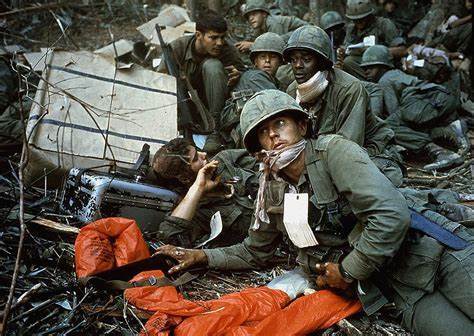
All of the American objectives were achieved, but at what cost? The Battle of Dak To claimed 376 Americans killed and 1,441 wounded. Of the 3,200 paratroopers deployed by the 173rd Airborne 27 percent were either killed (208) or wounded (645), with the rifle companies suffering 90 percent of the unit’s casualties.
The heavy combat throughout November strained not only the fighting forces of the 4th Infantry Division but also the doctors and nurses in the division’s 4th Medical Battalion. The medical staff in the field treated about 1,200 wounded American and ARVN soldiers during the weeks of continuous battle and managed to keep them alive while waiting for the evacuation helicopters to arrive.
“Every wounded soldier reached the 71st Evac Hospital at Pleiku alive,” stated William J. Shaffer, executive officer of Company B, 4th Medical Battalion, in Dyhouse’s article for VFW Magazine.
The legendary elite units, often the focus of battle tales popular with the public, are not the only ones that make vital contributions in combat—as the battle of Dak To shows.
Dana Benner holds a master’s degree in heritage studies. He teaches history, political science and sociology at the university level. Benner served more than 10 years in the U.S. Army. He lives in Manchester, New Hampshire.
This article appeared in the October 2021 issue of Vietnam magazine: https://www.historynet.com/dak-to-4th-infantry/?utm_source=facebook&utm_medium=social&utm_campaign=fb_vtm&fbclid=IwAR1qjfaQw0J3TIZLYLWXXWuc9KZ4v7xB49Tohb3vPglLhiu2x-HNTVcC4kM
Video/Song by Big & Rich depicting the battle of Dak To:
To read more about the Dak To battles on my website, click below for two more articles:
Invisible Enemy: Battle of Dak To
https://cherrieswriter.com/2017/01/03/12-major-battles-of-the-vietnam-war/
*****
Thank you for taking the time to read this. Should you have a question or comment about this article, then scroll down to the comment section below to leave your response.
If you want to learn more about the Vietnam War and its Warriors, then subscribe to this blog and get notified by email or your feed reader every time a new story, picture, video and changes occur on this website – the button is located at the top right of this page.
I’ve also created a poll to help identify my website audience – before leaving, can you please click HERE and choose the one item that best describes you. Thank you in advance!
August 3, 2023
30 Best Vietnam War Blogs and Websites
Jul 31, 2023
The best Vietnam War blogs from thousands of blogs on the web and ranked by traffic, social media followers & freshness.
Here are the 30 Best Vietnam War Blogs you should follow in 2023
1. Vietnam Veterans Memorial Fund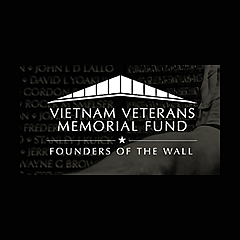 The Vietnam Veterans Memorial Fund is the nonprofit organization that founded the Vietnam Veterans Memorial in Washington, D.C. in 1982. VVMF’s mission is to honor and preserve the legacy of service in America and educate all generations about the impact of the Vietnam War and its era. Get deeper insights into the Vietnam War and the veterans in the blog.
The Vietnam Veterans Memorial Fund is the nonprofit organization that founded the Vietnam Veterans Memorial in Washington, D.C. in 1982. VVMF’s mission is to honor and preserve the legacy of service in America and educate all generations about the impact of the Vietnam War and its era. Get deeper insights into the Vietnam War and the veterans in the blog.
 Explore informative articles about artifacts in our permanent collection, topics & subjects related to military history, and Commonwealth connections. The Pennsylvania Military Museum is a community gathering place dedicated to exploring and showcasing Men & Women of Pennsylvania’s contributions to military innovation.
Explore informative articles about artifacts in our permanent collection, topics & subjects related to military history, and Commonwealth connections. The Pennsylvania Military Museum is a community gathering place dedicated to exploring and showcasing Men & Women of Pennsylvania’s contributions to military innovation.
 Sons and Daughters In Touch is an all-volunteer non-profit organization committed to ‘locating, uniting, and supporting’ the now-grown children of American servicemen who perished during the Vietnam War. Here you will find all their latest announcements, event reports, and official news updates.
Sons and Daughters In Touch is an all-volunteer non-profit organization committed to ‘locating, uniting, and supporting’ the now-grown children of American servicemen who perished during the Vietnam War. Here you will find all their latest announcements, event reports, and official news updates.
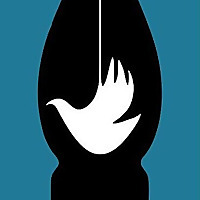 The Waging Peace in Vietnam exhibit and its companion book show how the GI movement unfolded, from the numerous anti-war coffeehouses springing up outside military bases, to the hundreds of GI newspapers giving an independent voice to active soldiers, to the stockade revolts and the strikes and near-mutinies on naval vessels and in the air force.
The Waging Peace in Vietnam exhibit and its companion book show how the GI movement unfolded, from the numerous anti-war coffeehouses springing up outside military bases, to the hundreds of GI newspapers giving an independent voice to active soldiers, to the stockade revolts and the strikes and near-mutinies on naval vessels and in the air force.
 Read blog entries written by Joe Campolo, Jr., author of The Kansas NCO Trilogy. A Vietnam War Veteran, Joe writes about the war and his many experiences including War stories, Fishing stories, sharing Rare photos & Press clippings. The blog also features guest writers from time to time presenting their unique experiences.
Read blog entries written by Joe Campolo, Jr., author of The Kansas NCO Trilogy. A Vietnam War Veteran, Joe writes about the war and his many experiences including War stories, Fishing stories, sharing Rare photos & Press clippings. The blog also features guest writers from time to time presenting their unique experiences.
 The website is of the HISTORY channel, a cable television channel that broadcasts historical documentaries and reality shows. The website features a wide variety of content, including articles, videos, timelines, interactive maps, and quizzes. It also offers a streaming service that allows users to watch full episodes of HISTORY shows. The Vietnam War lasted about 40 years and involved several countries. Learn about Vietnam War protests, the Tet Offensive, the My Lai Massacre, the Pentagon Papers, and more.
The website is of the HISTORY channel, a cable television channel that broadcasts historical documentaries and reality shows. The website features a wide variety of content, including articles, videos, timelines, interactive maps, and quizzes. It also offers a streaming service that allows users to watch full episodes of HISTORY shows. The Vietnam War lasted about 40 years and involved several countries. Learn about Vietnam War protests, the Tet Offensive, the My Lai Massacre, the Pentagon Papers, and more.
 POLITICO is the global authority on the intersection of politics, policy, and power. It is the most robust news operation and information service in the world specializing in politics and policy, which informs the most influential audience in the world with insight, edge, and authority. Read the latest news, headlines, analysis, photos, and videos on Vietnam War.
POLITICO is the global authority on the intersection of politics, policy, and power. It is the most robust news operation and information service in the world specializing in politics and policy, which informs the most influential audience in the world with insight, edge, and authority. Read the latest news, headlines, analysis, photos, and videos on Vietnam War.
 Folklife Today is a blog for people interested in folklore, folklife, and oral history. We feature brief articles on folklife topics, highlighting the unparalleled collections of the Library of Congress. These collections include songs, stories, traditional arts, cultural expressions, and oral histories of people from all over the country and the world.
Folklife Today is a blog for people interested in folklore, folklife, and oral history. We feature brief articles on folklife topics, highlighting the unparalleled collections of the Library of Congress. These collections include songs, stories, traditional arts, cultural expressions, and oral histories of people from all over the country and the world.
 At Atlas Obscura, our mission is to inspire wonder and curiosity about the incredible world we all share. We are a global community of explorers, who have together created a comprehensive database of the world’s most wondrous places and foods. The Vietnam War category on Atlas Obscura features a variety of sites related to the war. Learn more about the ‘Vietnam War’ on Atlas Obscura.
At Atlas Obscura, our mission is to inspire wonder and curiosity about the incredible world we all share. We are a global community of explorers, who have together created a comprehensive database of the world’s most wondrous places and foods. The Vietnam War category on Atlas Obscura features a variety of sites related to the war. Learn more about the ‘Vietnam War’ on Atlas Obscura.
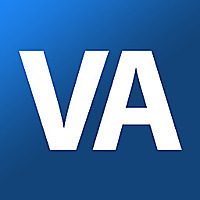 News and Information from the U.S. Department of Veterans Affairs. Read more on the stories, celebrations interviews, and other activities undertaken by the U.S Department of Veteran Affairs on the account of National Vietnam War Veterans Day here. Stay tuned for even more inspiring events.
News and Information from the U.S. Department of Veterans Affairs. Read more on the stories, celebrations interviews, and other activities undertaken by the U.S Department of Veteran Affairs on the account of National Vietnam War Veterans Day here. Stay tuned for even more inspiring events.
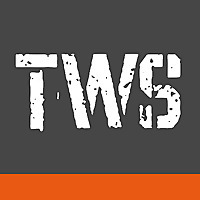 Together We Served is the largest U.S. Military Veteran website where Veterans reconnect with those they served with and create a record of their military service. The aim is to reconnect servicemen and women with those they served with and provide a secure and familiar online environment for Members to share in the camaraderie of others who served. Read stories about heroes of the Vietnam War in the blog.
Together We Served is the largest U.S. Military Veteran website where Veterans reconnect with those they served with and create a record of their military service. The aim is to reconnect servicemen and women with those they served with and provide a secure and familiar online environment for Members to share in the camaraderie of others who served. Read stories about heroes of the Vietnam War in the blog.
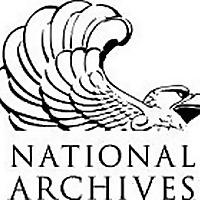 The Unwritten Record is the National Archives and Records Administration’s blog dedicated to special media holdings. The blog features information on fascinating finds, new accessions, preservation projects, and rediscoveries across the agency’s non-textual holdings.
The Unwritten Record is the National Archives and Records Administration’s blog dedicated to special media holdings. The blog features information on fascinating finds, new accessions, preservation projects, and rediscoveries across the agency’s non-textual holdings.
 The Hill is a top US political website, read by the White House and more lawmakers than any other site — vital for policy, politics, and election campaigns. Get the latest Vietnam War news brought to you by the team at The Hill.
The Hill is a top US political website, read by the White House and more lawmakers than any other site — vital for policy, politics, and election campaigns. Get the latest Vietnam War news brought to you by the team at The Hill.
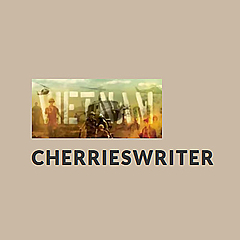 John is a published author of six books, three of which chronicle his experiences as an infantry soldier in Vietnam during 1970 / 1971. In this blog, you’ll find over 500 Vietnam War-related personal narratives, photos, videos, movies, artwork, war book reviews, and favorite music of the time.
John is a published author of six books, three of which chronicle his experiences as an infantry soldier in Vietnam during 1970 / 1971. In this blog, you’ll find over 500 Vietnam War-related personal narratives, photos, videos, movies, artwork, war book reviews, and favorite music of the time.
 Founded by Tara Ross, a retired lawyer and a former Editor-in-Chief of the Texas Review of Law & Politics. Read about her research and view on various subjects related to the Vietnam War, she has also talked about various martyrs, brave soldiers and more in the blog.
Founded by Tara Ross, a retired lawyer and a former Editor-in-Chief of the Texas Review of Law & Politics. Read about her research and view on various subjects related to the Vietnam War, she has also talked about various martyrs, brave soldiers and more in the blog.
 Read all featured articles on topics pertaining to the Vietnam War in this segment. Discover insightful, piercing commentary that sheds light on forgotten but important aspects of the war. The Vietnamese Magazine is an independent and non-profit online magazine that focuses on Vietnam’s politics.
Read all featured articles on topics pertaining to the Vietnam War in this segment. Discover insightful, piercing commentary that sheds light on forgotten but important aspects of the war. The Vietnamese Magazine is an independent and non-profit online magazine that focuses on Vietnam’s politics.
 Process – the blog of the Organization of American Historians, The Journal of American History, and The American Historian – strives to engage professional historians and general readers in a better understanding of U.S. history. On the following page, you can read articles and stories about the Vietnam War.
Process – the blog of the Organization of American Historians, The Journal of American History, and The American Historian – strives to engage professional historians and general readers in a better understanding of U.S. history. On the following page, you can read articles and stories about the Vietnam War.
 Fold3® provides convenient access to military records, including the stories, photos, and personal documents of the men and women who served. The records at Fold3 help you discover and share stories about these everyday heroes, forgotten soldiers, and the families that supported them. Stay updated and read about the war records, stories, photos, and more on Vietnam War here.
Fold3® provides convenient access to military records, including the stories, photos, and personal documents of the men and women who served. The records at Fold3 help you discover and share stories about these everyday heroes, forgotten soldiers, and the families that supported them. Stay updated and read about the war records, stories, photos, and more on Vietnam War here.
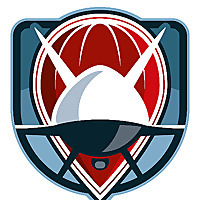 From Balloons to Drones is an online scholarly platform that seeks to analyze and debate air power history, theory, and current operations in their broadest sense, including space and cyber power. It recognizes that air power is more than just ‘aircraft, weapons systems, and bombing. Read posts about Vietnam War written by Ross on the following page.
From Balloons to Drones is an online scholarly platform that seeks to analyze and debate air power history, theory, and current operations in their broadest sense, including space and cyber power. It recognizes that air power is more than just ‘aircraft, weapons systems, and bombing. Read posts about Vietnam War written by Ross on the following page.
 The Oregon Department of Veterans’ Affairs (ODVA) is a state agency that serves Oregon’s veterans and their families. The blog posts in this tag cover a wide range of topics such as the history of the Vietnam War and its impact on Oregonians, the challenges faced by Vietnam veterans, such as post-traumatic stress disorder (PTSD) and Agent Orange exposure, and more.
The Oregon Department of Veterans’ Affairs (ODVA) is a state agency that serves Oregon’s veterans and their families. The blog posts in this tag cover a wide range of topics such as the history of the Vietnam War and its impact on Oregonians, the challenges faced by Vietnam veterans, such as post-traumatic stress disorder (PTSD) and Agent Orange exposure, and more.
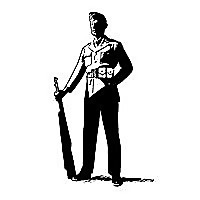 The Museum of the American G.I. is a living history museum dedicated to preserving the equipment, uniforms, and memories of all American Servicemen and women. Read in this article information about Vietnam Veterans Day, how it was established, and why it is so important to remember and celebrate every March 29th!
The Museum of the American G.I. is a living history museum dedicated to preserving the equipment, uniforms, and memories of all American Servicemen and women. Read in this article information about Vietnam Veterans Day, how it was established, and why it is so important to remember and celebrate every March 29th!
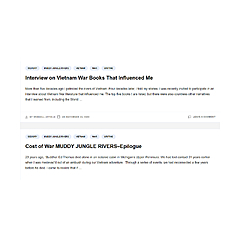 Dive into Wendell Affield’s memories and some poignant recollections of his days in the Navy during the Vietnam War. He also updates readers will his personal life, stories, and more. Wendell Affield is the author of the non-fiction work Muddy Jungle Rivers which recounts his days in the Navy.
Dive into Wendell Affield’s memories and some poignant recollections of his days in the Navy during the Vietnam War. He also updates readers will his personal life, stories, and more. Wendell Affield is the author of the non-fiction work Muddy Jungle Rivers which recounts his days in the Navy.
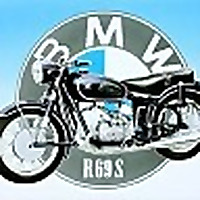 This blog is about observations, memories, travel, and perspective from my experiences. The seat of a motorcycle may seem a strange place from which to conjure blog stories, but, as many riders know, the burble of the wind, hum of the engine, and sensory saturation stimulate the mind causing it to dash to many places close and far. Read Vietnam War Stories on the following page of the blog.
This blog is about observations, memories, travel, and perspective from my experiences. The seat of a motorcycle may seem a strange place from which to conjure blog stories, but, as many riders know, the burble of the wind, hum of the engine, and sensory saturation stimulate the mind causing it to dash to many places close and far. Read Vietnam War Stories on the following page of the blog.
 NAMM is the music, sound, and event industry’s trade association. As your association, we work to grow the industry and support music-making worldwide. The category ‘Vietnam War’ contains interviews with people who served in the war and how it affected their lives and their music.
NAMM is the music, sound, and event industry’s trade association. As your association, we work to grow the industry and support music-making worldwide. The category ‘Vietnam War’ contains interviews with people who served in the war and how it affected their lives and their music.
 Founded in 1893, the University of California Press is one of the most forward-thinking scholarly publishers. Their mission is to drive progressive change by seeking out and cultivating the brightest minds and giving them a voice, reach, and impact. We write about the Vietnam War with the aim to impart knowledge and information about the events that took place.
Founded in 1893, the University of California Press is one of the most forward-thinking scholarly publishers. Their mission is to drive progressive change by seeking out and cultivating the brightest minds and giving them a voice, reach, and impact. We write about the Vietnam War with the aim to impart knowledge and information about the events that took place.
 Far Out is a British online culture magazine, headquartered in London and founded in 2010. Far Out focuses on independent and alternative culture, reviewing music, films and the arts along with relative interviews and curated playlists. Get detailed insights on the Vietnam war too in the blog.
Far Out is a British online culture magazine, headquartered in London and founded in 2010. Far Out focuses on independent and alternative culture, reviewing music, films and the arts along with relative interviews and curated playlists. Get detailed insights on the Vietnam war too in the blog.
 The IHB was created in 1915 as the Indiana Historical Commission. The Indiana Historical Bureau’s ‘Indiana History Blog’ informs readers about diverse history topics and the unique sources we use to research and write about them, such as correspondence, diaries, newspapers, patents, and maps. Read anecdotes, little-known stories, historical images, and more related to the Vietnam war in the blog.
The IHB was created in 1915 as the Indiana Historical Commission. The Indiana Historical Bureau’s ‘Indiana History Blog’ informs readers about diverse history topics and the unique sources we use to research and write about them, such as correspondence, diaries, newspapers, patents, and maps. Read anecdotes, little-known stories, historical images, and more related to the Vietnam war in the blog.
 The New Jersey Vietnam Veterans’ Memorial honors all those who served our country and state during the Vietnam War, especially the 1,562 New Jersey men and 1 woman who did not return home. It is a powerful and fitting tribute to their sacrifice. Their Blog aims to keep visitors updated on current events happening in the world and at the Memorial!
The New Jersey Vietnam Veterans’ Memorial honors all those who served our country and state during the Vietnam War, especially the 1,562 New Jersey men and 1 woman who did not return home. It is a powerful and fitting tribute to their sacrifice. Their Blog aims to keep visitors updated on current events happening in the world and at the Memorial!
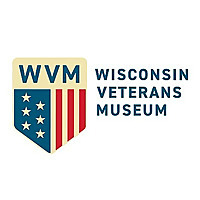 The mission of the Wisconsin Veterans Museum is to acknowledge, commemorate, and affirm the role of Wisconsin veterans in the United States of America’s military past and present. The museum has risen to become Wisconsin’s premier military museum and is a key educational activity of the Wisconsin Department of Veterans Affairs. Read stories of Vietnam War veterans in the blog.
The mission of the Wisconsin Veterans Museum is to acknowledge, commemorate, and affirm the role of Wisconsin veterans in the United States of America’s military past and present. The museum has risen to become Wisconsin’s premier military museum and is a key educational activity of the Wisconsin Department of Veterans Affairs. Read stories of Vietnam War veterans in the blog.
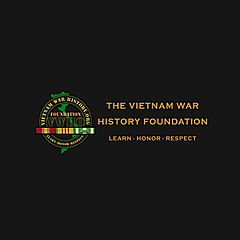 Vietnam War History Foundation was established to generate the resources that will allow us to hire researchers who can gather documents, photos, and maps at the National Archives on behalf of veterans and their families. Read the Vietnam War History in the blog.
Vietnam War History Foundation was established to generate the resources that will allow us to hire researchers who can gather documents, photos, and maps at the National Archives on behalf of veterans and their families. Read the Vietnam War History in the blog.
Vietnam War Newsletter
Vietnam War newsletter is a comprehensive summary of the day’s most important blog posts and news articles from the best Vietnam War websites on the web, and delivered to your email inbox each morning.
HERE IS THE LINK TO THE ORIGINAL ARTICLE WHICH INCLUDES ADDITIONAL DETAILS ABOUT EACH WEBSITE:
30 Best Vietnam War Blogs and Websites in 2023(opens in a new tab)blog.feedspot.com/vietnam_war_blogs/?...
July 29, 2023
Cherries – my Vietnam story by John Podlaski
This is a summary of ‘CHERRIES’ along with excerpts from the story as put together by the staff of Vietnam War Travel and featured on their website.
I went to Vietnam on August 4, 1970, and after a week of in-country training, I was assigned to the 1/27th Wolfhounds of the 25th Infantry Division at Cu Chi as an infantry soldier (Grunt). My unit operated out of Firebase Kien which was halfway between Dau Tieng and Saigon and not far from the Cambodian border in what the military referred to as III Corps.
After a few days of acclimation and gathering of supplies, I was flown out to the bush on the next company resupply. There, I was assigned to the 1st platoon of Company A and met up with a couple of former colleagues from AIT at Fort Polk, LA. During my time as a rifleman, I walked point and joined my fellow squad members in daily patrols and ambushes. When our M-60 gunner went home after a couple of months, it was easy to determine who the replacement would be – I happened to be one of the more muscled guys in my squad, and since I was also the youngest, was bestowed that privilege.
The gun – fondly referred to as “pig” took some getting used to when humping as it weighed 26 pounds, not counting the added weight of extra ammunition (pig food) that was either carried “Poncho Villa” style across the chest or wrapped around my waist. The tradeoffs were that I no longer had to walk point on patrols and was excused from half of the nightly ambushes.
I carried the “pig” for the next four months and then handed it off to a new “Cherry” when the lieutenant chose me to be his personal RTO (radio operator) for the platoon. This was a lot more work and responsibility, but the pro’s seriously outweighed the cons.
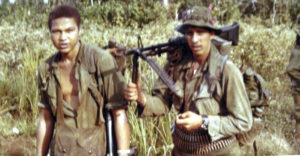 John Podlaski with “the pig” and his Detroit friend, Steve Blackburn
John Podlaski with “the pig” and his Detroit friend, Steve BlackburnIn March of 1971, the 25th Division was leaving Vietnam and returning to Hawaii, their base of operations. Anyone with nine months in-country would join them, all others would be reassigned to other units within the country. I was sent to the far north near the DMZ (I Corps) and reassigned to Company A, 1/501st, 101st Airborne Brigade. With five months left in my tour and temporarily assigned to guard at Camp Vandegrift, I learned about one of the RTOs in the company command platoon (CP) who was going home when the company returned to the base in a couple of days – I campaigned hard for that position and became the personal radio operator for the Alpha Company commander before their next mission; it turned out to be a position nobody else wanted anyway. I remained in that position until a couple of weeks shy of completing my tour when I was promoted to sergeant and placed on special assignment until it was time for me to go home.
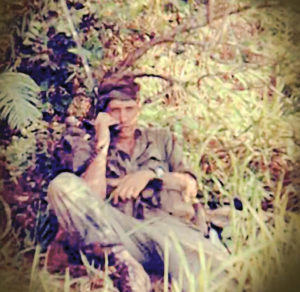 Podlaski as an RTO
Podlaski as an RTOAfter Vietnam and a thirty-day leave, I reported to Fort Hood and was assigned to HHC 1/12th, 1st Cav Division, heading up the battalion radio repair unit (which turned out to be only me). It was a decent position where I learned to fix PRC-25 radios and to drive APC’s during week-long war games.
The military gave me an early out and I left the Army on December 12, 1971.
*****
Here are some excerpts from my book and website articles:
“…During the Vietnam war, newly arrived soldiers were referred to as Cherries (virgins to war). At least this is how it was in the infantry. I’ve heard other acronyms as well such as FNG (fu*king new guy), Newbie, and fresh meat, but they weren’t used as often. A grunt (infantry soldier) remained a Cherry until he lost his innocence, which was usually after his first firefight. I remember seeing war movies growing up where everyone was depicted as a brave warrior, rushing the enemy through a wall of flying steel. Let me tell you that almost every soldier still remembers his first firefight. It doesn’t have to just be Vietnam, it could be Korea, WWII, Iraq, or anywhere else where you are put in harm’s way. In my case, I was so scared and felt paralyzed and helpless as I lay on the jungle floor – bullets popping overhead and impacting all around me. Only two thoughts were going through my head at that time: how to sink deeper into this ground and I hope I don’t get hit.
The firefight itself is just a small part of losing your virginity and much of the time it only lasts a few moments before the enemy retreats. It’s what you see afterward that stays with you forever. Soldiers you just met are laying seriously wounded or dead, flesh and body parts are strewn about, and blood is everywhere! Your gag reflex was on overdrive. Rarely did I see a dead enemy soldier in Vietnam as bodies were customarily taken when the enemy withdrew. And this made life frustrating!”
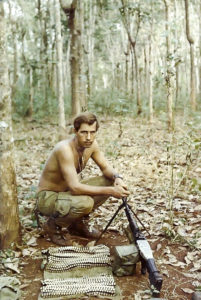 After a few months, you’re not an “FNG” any longer
After a few months, you’re not an “FNG” any longer“…There is some comparison between a Cherry and a freshman in his first year of high school. Just think about it. You are scared, apprehensive, don’t know anybody, hope you fit in, and you know there is much to learn before you are able to graduate. With this in mind, add to it the threat of death or maiming to your daily routine – somebody may jump out of a locker in the hallway and shoot you (although today that’s not really far-fetched). You must be hyper-vigilant just to survive 365 days in this school. And still the learning continued.”
“…Let me preface this post by saying that over 2.5 million U.S. men and women served in Vietnam during the time period of 1959 – 1975. However, only 10% of the total were in the Infantry and ‘humped the boonies’ in search of the elusive enemy, the remaining 90% supported them in various capacities, their tasks, at times, more dangerous than those searching through the jungles. Helicopter crews were held in the highest regard and seen as “saviors” by the infantry soldiers, at times, watching in awe and disbelief while pilots braved enemy onslaughts to transport, rescue, supply, and protect those on the ground. Crews were always there when needed – losing many of their own while performing in this role. Other supporting groups, stationed in rear areas or fire bases were also at risk of enemy mortar and rocket attacks, ground assaults, or ambushes when traveling outside the base along roads in supply caravans. The ‘grunts’ or ‘boony rats’ had to contend with enemy ambushes and booby traps, sometimes walking directly into well-camouflaged enemy bunker complexes and getting pinned down for hours in the middle of the jungle. It was a deadly tour for everyone – no one group was safer than the other! This article will focus only on those Cherries within an infantry unit. Certainly, each military unit received new replacements throughout the war; their indoctrination to war may have been quite different to what is written here.”
“…Imagine, if you will, that most Cherries in Vietnam had graduated from high school within the past year; some never finished and were quickly drafted into the military. In Vietnam, these eighteen-year-old soldiers were thrust into a hostile environment where they had to do things never imagined in their wildest of dreams or even thought of as humanly possible to achieve. Nineteen-year-old corporals and sergeants oversaw squads and twenty-one-year-old Lieutenants and Captains ran the platoons and companies. Turnover was rampant and a soldier with experience in the jungle was highly respected – regardless of age – and in most cases was a lower ranked enlisted man and not an officer.”
“…To understand this feeling, imagine yourself waking up in your bed during the middle of the night; the room in complete darkness – suddenly the bedroom floor in the old house creaks – sending a chill up your spine.
Your mind suggests that a stranger is moving toward the head of your bed – he’s unable to see you but knows you are there. You break out in a cold sweat, and your heart begins racing, the beats gaining momentum and pounding loudly like a large drum in the dark quiet of the night. You hope the intruder doesn’t hear your beating heart and give away your location. You lay paralyzed, frozen to the spot, and too afraid to move your head or sit up to have a look around – let alone get up out of bed to turn on the light (not an option in the jungle). This is real fear! …”
“…Today, I want to write more about another fear these young men had to endure while living in the jungles. Mother Nature had created many wonderful things over time; some were beautiful, and others were downright frightening. The jungles of Vietnam were home to every creature, beast, and insect known to man. Some veterans attest to seeing tigers and elephants in the boonies, but I can’t say that I saw either. However, I had seen many wild boars, cobras, small and deadly viper snakes, different spiders, and a few boa constrictors. Someone once said that Vietnam was home to 100 different species of snakes – 98 were poisonous and the other 2 could crush a person to death.
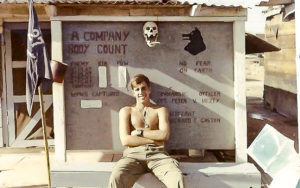 Podlaski managing a smile in the midst of war
Podlaski managing a smile in the midst of warTarantulas (and other species/sizes of spiders – some the size of dinner plates), red ants, and black horseflies all hurt like hell when they bit. Bees, wasps, hornets, centipedes, millipedes, lizards, frogs, rats, scorpions, land and water leeches, orangutans, spider monkeys, bats, and hordes of mosquitoes attacked us whenever we entered their domain. The liquid bug juice supplied by the military kept many of the flying insects from landing on bare skin but did nothing to prevent those long-beaked malaria-carrying insects from biting you through clothes. I’d try to cover my head at night with a poncho liner to keep the mosquitoes away, but it was hot and uncomfortable and there was no escaping the constant buzzing in my ears as the blood-thirsty swarms hovered above my head, waiting patiently for an opportunity to taste the sweet nectar.
Another heartstopper is when you felt something moving across your body during the night – there were no lights to turn on or flashlights available to investigate – besides, any light or noise in the dark jungle would be a beacon to those who want to kill me. You took your chances and either swatted, brushed, jumped up from the ground, or just left it alone. Some of these creatures had claws that gripped you; swatting at them usually pissed them off and resulted in a retaliatory bite, sting, or pinch. Most of the above were poisonous and could make one very sick or even kill.
Someone once said that what you can’t see won’t hurt you. That might work for your peace of mind during the night, but let me tell you, these creatures were always found in the damnedest of places first thing in the morning. You could find them in your pockets, boots, helmet, rucksack, canteen cup, or laying with you under the warmth of your lightweight poncho liner blanket. A search and destroy effort was usually the first thing on the agenda every morning.”
John keeps on writing, sharing his and other’s experiences, make sure to check out his website for even more stories and facts you never knew about on: https://cherrieswriter.com/
To learn more about John Podlaski’s books, please click on the link below:
This article originally appeared on https://namwartravel.com/cherries/
*****
Thank you for taking the time to read this. Should you have a question or comment about this article, then scroll down to the comment section below to leave your response.
If you want to learn more about the Vietnam War and its Warriors, then subscribe to this blog and get notified by email or your feed reader every time a new story, picture, video and changes occur on this website – the button is located at the top right of this page.
I’ve also created a poll to help identify my website audience – before leaving, can you please click HERE and choose the one item that best describes you. Thank you in advance!
July 22, 2023
The Unbelievable True Story Of John Donohue And ‘The Greatest Beer Run Ever’
By Marco Margaritoff |
This is the true story of a former Marine, John “Chickie” Donohue, who in November 1967, snuck into Vietnam and braved actual firefights — just so he could bring his army buddies from back home some cold beers. Read the facts here before the movie premiers this fall.

Pabst Blue Ribbon/YouTubeDonohue eating rations (right) with friend Rick Duggan (opposite, with box in front) and members of the First Air Cavalry’s Bravo Company.
John “Chickie” Donohue served four years in the Marines but missed the war. He had only ever been to Vietnam twice as a merchant seaman, but knew dozens of soldiers risking their lives overseas. Offended by the anti-war protests in his city, the New Yorker decided to return to Vietnam — to bring the troops cold beer.
It began on a winter night in November 1967. Donohue was having a drink at Doc Fiddler’s on 275 Sherman Avenue in his native Inwood neighborhood when news coverage of demonstrators in Central Park blared on the television. Patrons denounced them as naive idealists, while bartender George Lynch hatched a plan.
“Somebody ought to go over to ‘Nam, track down our boys from the neighborhood, and bring them each a beer!” Lynch said.
As detailed in his book The Greatest Beer Run Ever, A Memoir Of Friendship, Loyalty, And War, Donohue set out on an ambitious four-month odyssey that spanned more than 8,000 seafaring miles. From New York City to Qui Nhon, he was armed with nothing but a list of names — and a trove of beer clanking below deck.
John “Chickie” Donohue Sets SailJohn Donohue was born in New York City in 1941. He was raised in the northern Manhattan neighborhood of Inwood which was largely populated by Irish-Americans such as himself at the time. He spent his youth running around town with friends Tommy Collins and Rick Duggan.

Rick Duggan Donohue on the Drake Victory.
Donohue enlisted in the Marine Corps when he came of age. He learned how to handle weapons but never experienced combat. A marine merchant after that, he used his seaman’s identification card that confirmed he could handle ammo to deliver supplies to Vietnam. But at the height of the war in 1967, he felt useless.
Donohue knew at least 28 people from his Inwood neighborhood who had died in Vietnam and felt the rabid demonstrations against the war disrespected their sacrifice. Sitting at Doc Fiddler’s, he couldn’t help but feel Lynch’s suggestion of a globe-spanning beer run was worthwhile. After all, those soldiers could die in the blink of an eye.
“They were like my kid brother’s age, but I knew them,” said Donohue. “I grew up in the same houses. But I’ll tell you what really provoked my trip. The demonstration in Central Park. The protesters would carry a Vietcong flag. They would chant murderers, baby killers, all this other stuff.”
Lynch, the bartender at Doc Fiddler’s, had only made Private First Class but was a patriot through and through, who organized local Memorial Day and Independence Day parades. He even erected a flagpole on the corner of Sherman Avenue. Known as the “Colonel,” he asked Donohue for his seaman’s card — when Donohue decided to deliver the beer himself.
The word spread like wildfire. Tommy Collins’ mother gave Donohue $100 to bring to her son, but Donohue rejected the cash and focused on the mission. He resourcefully found a job as an oiler on the Drake Victory, which was about to haul ammo to Vietnam. With a bag full of beer, Donohue took to the sea.
The Greatest Beer Run EverDonohue arrived In January 1968 after two months at sea. Most soldiers thought he was in intelligence, as he was dressed in a plaid shirt and corduroy pants. He set course for Duggan who was fighting in Khe Sanh as a specialist in the Army First Air Cavalry Division, and told anyone inquiring that he was Duggan’s stepbrother.

Pabst Blue Ribbon/YouTubeThe 8,000-mile journey took two months.
“It took two months to get there, so I drank all the beer,” said Donohue.
After restocking the payload of PBR and Schlitz, he embarked on a string of U.S. military convoys, planes, and helicopters to Khe Sanh. Donohue let low-ranking soldiers in on his mission and found them eager to help while mentioning they’d love a cold beer, themselves. He wisely kept quiet around high-ranking officers.
“‘If I told you the truth, you would not believe me,’” he said. “The longer I was there, I became aware that they’re deferring to me and they didn’t stop me. And I knew the lingo from being in the Marines. So it just worked.”
Tommy Collins was the first friend on Donohue’s list to encounter the casually dressed civilian. “‘What the hell are you doing here?’” Collins recalled saying. “He’s in a combat zone, and here he is walking around like he’s going on a golf outing or wherever the hell he’s going.”
Donohue forged ahead to find Duggan. He had hitched a helicopter ride to a northern outpost in the Quang Tri when he did — and also found the province under attack by the North Vietnamese Army.
“Chickie! Holy s**t! What the hell are you doing here?!” Duggan said. Donohue casually replied: “I brought you some great beer from New York.

Pabst Blue Ribbon/YouTubeDonohue (left) with Duggan’s men.
When enemy troops began firing, Duggan threw Donohue an M97 grenade launcher. When the dust settled, Donohue watched as Duggan and two others on his list “popped the cans open and … took their first sip of beer in a while.”
It was the perfect moment for Donohue to tell Duggan his mom wanted him to attend mass.
John “Chickie” Donohue Escapes From VietnamDonohue had only found four of the six men he intended to find, as one had died during his beer run and another was sent home with malaria. He shared news of Jefferson Airplane’s new album and NFL coach Vince Lombardi retiring — before a chorus of bewildered soldiers he met reminded Donohue to head back.
“Wait a minute,” one soldier said. “You’re telling me you don’t have to be here and you’re here?”
Donohue trekked to Saigon a few weeks later to catch a flight to Manila to board his ship back to New York. The Vietcong had overrun Saigon as part of the Tet Offensive, however, and were gunning people down in front of the U.S. embassy. Remarkably, the unarmed civilian made it out alive — and back to Doc Fiddler’s.
“The Colonel, who never drank on duty, poured himself and everyone else a beer and raised it,” said Donohue. “‘To Chickie,’ he said, ‘who brought our boys beer, respect, pride — and love, goddamn it.’”
Donohue returned a changed man and found himself agreeing with the Vietnam war protests he had admonished just a couple of months earlier. He realized the state department had lied about winning the war, and wanted his friends to return home safely. Fortunately, all four of them did — and have beers with Donohue to this day.
“He came through at a time when society didn’t want us and the protesters were on us,” said Collins. “But that’s Chickie. He’s one of the nicest but craziest guys you ever want to meet.”
This story was made into a movie that will premiere in the fall of 2023.
This article was featured on ATI and published on December 14, 2021. Here is the direct link: https://allthatsinteresting.com/john-chickie-donohue?fbclid=IwAR2KntXobsFpHQUFKVpg9ACXAjwFSDpMa61iHJrz5wpj9brSZLv8rowmhj4
Watch this video as Donahue reminisces about the beer run with his buddies.
Here is a preview of the upcoming movie:
*****
Thank you for taking the time to read this. Should you have a question or comment about this article, then scroll down to the comment section below to leave your response.
If you want to learn more about the Vietnam War and its Warriors, then subscribe to this blog and get notified by email or your feed reader every time a new story, picture, video and changes occur on this website – the button is located at the top right of this page.
I’ve also created a poll to help identify my website audience – before leaving, can you please click HERE and choose the one item that best describes you. Thank you in advance!
July 15, 2023
THIS PLANE MADE ALL THE DIFFERENCE IN VIETNAM — SO DID ITS AVIATORS
An O-2A Super Skymaster piloted by a Forward Air Controller (FAC) fires a smoke rocket at an enemy strongpoint to mark it as an airstrike target. The O-2 proved an ideal aircraft for the dangerous and demanding tasks of FAC pilots. (U.S. Air Force)
Bird Dog aircraft and pilots were a tremendous help to those units in the field. I had the opportunity to work with these pilots while on missions; they were the orchestra conductors of heavy-duty support and helped to get us out of trouble. A heroic O-2 pilot was depicted by Danny Glover in the BAT-21 movie. Read how these weapons/aircraft came to be.
By Barry Levine
A Cessna O-2’s night reconnaissance mission turned tragic on Christmas Day, 1967. Near the Demilitarized Zone, Maj. Jerry Sellers (pilot) and Capt. Richard Budka (observer) received a radio message about a ground patrol in trouble. Quickly flying towards the area, Sellers turned on his landing lights to direct fire from a nearby AC-47 gunship towards the enemy—putting himself and Budka at high risk. Hit by ground fire, the subsequent crash killed both men. Sellers was posthumously awarded the Air Force Cross. The crew’s bravery allowed the ground patrol to return to safety.
Forward Air Controllers (FACs) were integral to America’s war effort in Vietnam, using various aircraft. One such aircraft—the Cessna O-2—was a modified civilian 337 Skymaster and flew a wide range of missions during the war. Then-Lt. Mike Jackson’s memoir Naked in Da Nang noted: “FACs…plodded along at ridiculously low levels to direct airstrikes, observe troop movements, gather intelligence, and/or choreograph search-and-rescue missions…we were the traffic cops of Southeast Asia, telling everyone where to go, when to go, how to get there, and what to do once they were there.”
Cessna and military aviation have a long history together, as Cessnas were used as World War II trainers and transports. After the war, Cessna designed the single-engine Model 305 with tandem seating for recreational aviation. In turn, the 305s were repurposed by the military into the L-19 “Bird Dog,” seeing service in Korea as observation aircraft.
Redesignated as the O-1 in 1962, Bird Dogs were used extensively in Vietnam and Laos. Their slow speed, limited range, and small ordnance-carrying capacity reduced their effectiveness. The Air Force began searching for more advanced aircraft. At home, Cessna continued developing civilian models such as the 336—first flown in February 1961. This aircraft featured engines in front of and behind the fuselage and twin cantilever booms, which helped avoid yaw if one engine failed.
 A Cessna O-2 soars above Pleiku in 1968. The O-2 was faster and could hover over target areas longer than its predecessor, the Cessna O-1 Bird Dog. (U.S. Air Force)
A Cessna O-2 soars above Pleiku in 1968. The O-2 was faster and could hover over target areas longer than its predecessor, the Cessna O-1 Bird Dog. (U.S. Air Force)Re-engineered with improved performance and retractable landing gear in 1964, the 336 aircraft became the Model 337 Skymaster. With two 210-hp Continental engines, these new aircraft had a top speed of about 200 miles per hour and a range of more than 1,000 miles. The Skymaster had a wingspan of over 38 feet and was about 30 feet long. The Air Force evaluated over 100 civilian aircraft before deciding in 1966 that the Skymaster, while imperfect, was the best short-term option to replace the O-1. Renamed the O-2 (and earning nicknames such as “Oscar Deuce”), about 450 were deployed to Southeast Asia. O-2s were faster, had longer loiter time over a target, carried more ordnance, and had better instrumentation for night missions compared to O-1s. Two variants saw action: O-2As for FAC missions and O-2Bs for psychological operations.
 Cartoon character Snoopy was popular with Tactical Air Support Squadron (TASS) units. (Guy Aceto Collection)
Cartoon character Snoopy was popular with Tactical Air Support Squadron (TASS) units. (Guy Aceto Collection)Military reconfiguration of Skymasters added observation windows, 7.62mm miniguns, LAU-59/A pods holding Folding Fin Aircraft Rockets, armored seats, self-sealing fuel tanks, and stronger landing gear.
O-2 pilots considered the Air Force-designed gunsights ineffective. To improve accuracy, some pilots used a grease pencil mark on the windshield, coordinated with the seat and pilot’s height, as an alternative gunsight.
The U.S. military introduced O-2s into Vietnam beginning in May 1967. This first required getting the aircraft to Asia, which was not a straightforward process. Civilian pilots flew O-2s in flights of four from Cessna’s Wichita, Kansas, plant to Hamilton AFB in California. At Hamilton, the Air Force removed all the seats except the left front and installed extra fuel and oil tanks and an emergency radio. Still flown by civilians, these aircraft island-hopped from California to Vietnam, with flight leaders earning $1,000 and other pilots $800 for the trip, plus airfare home. The Hamilton-Hawaii leg was the longest at about 13 hours of flight time; fuel aboard provided for about 14.5 hours of flight, leaving a small margin for navigational error. Years later, an anonymous Air Force pilot wrote: “Civilian misfits ferrying Air Force airplanes across the Pacific to a combat zone? No way!… We began firing off messages to get this idiocy stopped.” The Air Force ultimately assumed responsibility for aircraft delivery.
O-1 pilots stationed in Vietnam received field training for the new aircraft. The 20th Tactical Air Support Squadron (TASS) was the first FAC unit to receive these aircraft and the first O-2 qualified pilot was Maj. James Leatherbee, who described the Cessna as “an ideal plane for FACing.”
For pilots receiving training in the U.S., flight qualification was at Hurlburt Field in Florida (sometimes referenced as “FAC U”). Instruction included Air Ground Operations schooling for coordinating with ground troops, and Fighter Lead-in Training (conducted at Cannon AFB in New Mexico) to ensure that airmen directing attacks near U.S. troops were qualified fighter pilots. Graduates from Cannon were classified as “A” pilots. Those without that training were rated as “B” pilots and relegated to directing attacks only near non-U.S. allied troops. There was an ongoing dispute within military leadership about the tradeoff between fighter pilot training (increasing FAC effectiveness) and the need for aircraft in the sky (given the expanding operational tempo).
Other facets of a pilot’s education included the Survival, Evasion, Resistance, and Escape School at Fairchild AFB in Washington State and the Jungle Survival School at Clark Air Base in the Philippines. After arriving in Vietnam, pilots provided detailed personal information to military intelligence, such as describing their tattoos and scars, to help search-and-rescue teams avoid potential North Vietnamese traps. After arriving in-country, pilots would fly observation missions to become familiar with the terrain and received a check ride with an experienced FAC. They were then deemed to be ready for combat.
Call signs were ubiquitous for FAC pilots, regardless of the type of aircraft flown. For example, “Nail” FACS were assigned to the 23rd TASS, and “Covey” FACS to the 20th TASS. These call signs were common self-references that the airmen might use long after their military service concluded.
 These illustrations from the F-100 Forward Air Control (FAC) operating manual show the flight patterns used by FAC pilots when conducting reconnaissance for air strikes. FACs marked enemy positions with white phosphorus, signaling where fighters should aim their bomb strikes. Being a FAC required great focus, accuracy, and fast reflexes. (U.S. Air Force)
These illustrations from the F-100 Forward Air Control (FAC) operating manual show the flight patterns used by FAC pilots when conducting reconnaissance for air strikes. FACs marked enemy positions with white phosphorus, signaling where fighters should aim their bomb strikes. Being a FAC required great focus, accuracy, and fast reflexes. (U.S. Air Force)The Air Force developed an extensive command structure for the FAC effort. The 504th Tactical Air Support Group headquarters had nearly 3,000 personnel by 1968. There were five TASS units: the 19th at Bien Hoa; the 20th at Da Nang; the 21st at Nha Trang and Cam Ranh Bay; the 22nd at Binh Thuy; and the 23rd at Nakhon Phanom in Thailand. These squadrons used about 70 forward operating bases.
CESSNA O-2Crew: 2
Length: 29 ft 9 in
Wingspan: 38 ft
Height: 9 ft 4 in
Empty weight: 2,848 lb
Max. takeoff weight: 5,400 lb
Power: 2 × Continental IO-360C/D air-cooled flat-six engines, 210 hp each
Maximum speed: 199 mph at sea level
Cruise speed: 144 mph at 10,000 ft
Range: 1,060 mi
Service ceiling: 19,800 ft
Guns: 7.62mm SUU-11/A Minigun Pod
Hardpoints: Four MAU-3A bomb racks
Rockets: LAU-59/A Rocket Launcher, MA-2/A Rocket Launcher
Bombs: SUU-14/A Bomblet Dispenser
Being a FAC was a high-intensity job, both in the number of sorties flown and performance requirements on each mission. The 1967 flight manual “FAC Procedures–Target Marking” directed that FACs: “[perform] an area reconnaissance of the target area prior to the arrival of the strike aircraft…to confirm the position of friendly forces and study the target terrain, weather, etc. All operations in the target area should be at an altitude above the effective range of small arms fire [approximately 1,500 feet above ground level] unless there is an urgent operational requirement to fly lower. The FAC should have a plan or system but should not establish a set pattern [and] take advantage of sun, clouds, speed, binoculars, etc., to protect and separate himself from the enemy.”
Once assigned to a squadron, FACs would be given specific areas of responsibility (AORs). Pilots were expected to become familiar with their AOR’s terrain and to be alert for changes indicating enemy troop or supply movements. Telltale signs of the enemy would be fresh tracks or smoke from a cooking fire. The movement of water buffalo out of the fields could signify an imminent firefight—villagers would not want to put these animals at risk.
Intelligence, navigators, or maintenance personnel might accompany pilots for daytime missions. FAC missions involved marking enemy positions with white phosphorus (“Willie Pete” in G.I. vernacular) rockets, signaling where the fighters should aim their bomb strikes. If the FAC thought the placement was satisfactory, he would call “hit my smoke” as the target for the first bomb. The pilot’s next call would be “cleared hot”—green-lighting the first fighter attack. The initial action would be followed by any necessary coordination for additional strikes on the enemy.
Accuracy in marking enemy positions was paramount, as North Vietnamese forces were often close to U.S. and South Vietnamese troops. Given the proximity of the FACs to other U.S. aircraft, often moving overhead at very high speeds, O-2s might have their wing tops painted white to contrast with the jungle terrain. For night missions, O-2s would be painted black and the observer would use a starlight scope to amplify starlight and moonlight. These scopes were effective in illuminating trucks on the Ho Chi Minh trail, leading to the destruction of enemy vehicles.
O-2s were employed for other critical purposes, including assessing bomb damage after B-52 missions and, if circumstances warranted, requesting an attack by the B-52s. It was a risky assignment. The aircraft would circle at low altitudes to review the bombing damage while simultaneously avoiding bombs dropped from the higher-altitude B-52s.
 An F-100 Super Sabre, call sign Yellow Jacket 11, releases its bomb load over a designated target area in September 1969. (U.S. Air Force)
An F-100 Super Sabre, call sign Yellow Jacket 11, releases its bomb load over a designated target area in September 1969. (U.S. Air Force) FAC played an instrumental role in this air strike northwest of An Loc in September 1969, in which a 500-lb. bomb killed an estimated 12 enemy soldiers, destroyed 44 bunkers, and exposed additional enemy bunkers and resources. (U.S. Air Force )
FAC played an instrumental role in this air strike northwest of An Loc in September 1969, in which a 500-lb. bomb killed an estimated 12 enemy soldiers, destroyed 44 bunkers, and exposed additional enemy bunkers and resources. (U.S. Air Force )FACs also supported the insertion/extraction of special forces teams in Laos and Cambodia. They coordinated helicopter and aircraft rescues of downed aircrews. Command Master Sgt. Craig Corbett recounted after bailing out of an AC-119 “Flying Boxcar” (7.62mm and 20mm mini-guns/cannons) gunship near An Loc, South Vietnam: “I turned on my survival radio and heard the pilot of the O-2, whose call sign was Sundog, talking to one of our guys on the ground. Waiting a few seconds…I too made contact with Sundog who said, ‘Sit back, relax, Sandy [the call sign for the rescue teams] is on its way’.…I told myself all would be okay.”
Psychological operations involving O-2B missions included loudspeaker broadcasts and dropping leaflets into enemy positions from a chute installed for this task. The 9th Special Operations Squadron, operating from Da Nang, Phan Rang, Tuy Hoa, and Bien Hoa airbases, engaged in these exercises as part of a broader effort to break the will of enemy soldiers. Broadcasts included a series of pained moans interspersed with Vietnamese music, reminding North Vietnamese fighters of home and the risk of death if they continued fighting.
While these missions were challenging and risky, FAC pilots faced other complications. One was the Rules of Engagement, which provided restrictive, confusing, and contradictory procedures on what could or could not be done in combat situations. Attacking Buddhist temples in Cambodia was off-limits, for example. The Communists exploited these constraints by purposely placing weapons in religious temples to shoot at U.S. aircraft. Having to strictly abide by these rules in the face of enemies exploiting them demoralized many American personnel.
Radio communications pilots required expert knowledge, adding to the other challenges they confronted. O-2s were equipped with UHF radios for coordinating with nearby tactical aircraft, FM for communicating with ground troops, and VHF for contacting tactical air control and requesting air support.
Personal safety was a constant concern. Many pilots wore Kevlar flak vests and would sit on a spare vest when airborne for added protection. Flight helmets provided protection against small arms fire. Pilots would be issued personal weapons such as a Smith & Wesson Model 10/Victory Model .38 Special and an M-16. While enemy forces might withhold fire on the FAC if they had not been spotted, all bets were off if the enemy thought they had been seen.
Combat damage resulting from the heavy use of the O-2s required extensive field maintenance. Some maintenance personnel received stateside training from Air Force or Cessna technicians at bases such as Sheppard AFB in Wichita Falls, Texas. For others, on-the-job training was the norm. One airman recalled being given a toolbox, the O-2 instruction manual, and being told “Go fix it.” All the same, pilots gave high praise to the quality of their ground maintenance crews.
Courage was never in short supply in the FAC units. Lt. Jackson’s memoir describes an O-2 mission near Hue in mid-1971. Without an observer on board, he was in continuous contact with South Vietnamese forces on the ground (who had rudimentary English skills) while coordinating with nearby F-4 Phantom pilots in dealing with a North Vietnamese attack. Jackson came under heavy ground fire. The ARVN commander on the ground radioed for Jackson to be “careful.” He later wrote: “The ARVN Commander knew that…without me, his unit had a life expectancy of about 20 minutes.” Ultimately promoted to lieutenant colonel, Jackson later became the executive director of the National Aviation Hall of Fame at Wright-Patterson AFB.
This article appeared on the History dot com website on 6/12/23. Here’s the direct link: https://www.historynet.com/cessna-o2-vietnam/
*****
Thank you for taking the time to read this. Should you have a question or comment about this article, then scroll down to the comment section below to leave your response.
If you want to learn more about the Vietnam War and its Warriors, then subscribe to this blog and get notified by email or your feed reader every time a new story, picture, video and changes occur on this website – the button is located at the top right of this page.
I’ve also created a poll to help identify my website audience – before leaving, can you please click HERE and choose the one item that best describes you. Thank you in advance!
July 8, 2023
In 1968, A Secret U.S. Military Base Was Overrun By Elite North Vietnamese Commandos
Decades ago on March 12, 1968, a top-secret U.S. base on a mountaintop in Laos was overrun by an elite force of North Vietnamese commandos. Only six of the eighteen CIA and Air Force personnel manning the remote outpost escaped with their lives in an incident that would remain veiled in secrecy for three decades.
This was because the U.S. military was legally prohibited from operating in Laos. The southeast Asian nation had been wracked by a civil war pitting right-wing royalists against Pathet Lao communists—the latter backed by North Vietnam, which used Laotian territory to clandestinely funnel troops into South Vietnam via the Ho Chi Minh trail. However, in 1962 Washington, Hanoi and Laotian factions all signed a peace treaty in which the foreign powers agreed to withdraw their forces from the country.
However, North Vietnam only withdrew a minority of its forces, and the United States continued transferring extensive military aid to the royalist and instead began a secret but large-scale aerial bombing campaign in the kingdom known as Operation Barrel Roll. Though warplanes based in Vietnam and Thailand flew missions into Laos, CIA-run mercenary contractors and ‘airlines’ such as Air America flew transport and observation aircraft from Laotian bases.
CIA personnel also recruited local Hmong, an ethnic minority present in several Southeast Asian states, to fight a guerilla war against the Pathet Lao. It was with this purpose in mind that CIA personnel first established a base atop the steep cliff of Phou Pha Thi mountain, a sacred place in the Hmong’s animist faith which happened to be strategically located near the border with North Vietnam.
This base was one of many ‘Lima Sites’ in Laos intended to facilitate the aerial supply of U.S.-allied forces. The main facility was at the peak of the 5,600-foot high mountain surrounded by steep cliffs; you can see the base’s layout in this photo. A path wound downslope to a short 700-meter-long airstrip at the base of the mountain was used for resupply and staff rotations, delivered in covert weekly flights by CH-3 helicopters of the 20th U.S. Air Force helicopter squadron.

In the summer of 1966, the U.S. Air Force decided to adapt the base with a new purpose—to serve as a radar-navigation system, or TACAN, by installing a power generator and first a transponder. In the era predating GPS, TACAN sites helped warplanes find their targets, especially, while flying under low visibility conditions or at night. (The first radio navigation system, known as Knickebein, was developed by Nazi Germany, to enable more precise night bombing of England.) In 1967, this was further upgraded to a TSQ-81 antenna and remote bombing system that allowed the base to remotely control U.S. bombers.
Hanoi was only 135 miles northeast of Lima 85, so the clandestine base was able to direct very precise coordinates for U.S. aircraft bombarding the North Vietnamese capital. Because those strikes could involve anything from F-105 fighter bombers to dozens of huge B-52 bombers, this made the base a deadly force multiplier. In just six months, Lima 85 directed between 25 and 55 percent of the air strikes pounding North Vietnamese and Laotian targets.
Because Laotian Prince Souvanna refused to accept U.S. military personnel in Laos, U.S. Air Force personnel deployed to Lima 85 had to sign papers temporarily discharging them from the U.S. military before deploying to Lima, a farcical process known as ‘sheep dipping.’ These technicians were supposed to go unarmed, though they did eventually end up acquiring a handful of small arms. Instead, the base’s security was supposed to be assured by a battalion of Hmong militia—advised by CIA agents—and Thai Border Patrol policemen deployed around the base of the mountain.

However, Lima 85 may have been concealed from the U.S. public, but its presence and purpose were not a secret to the Pathet Lao and North Vietnamese Army (NVA). Scouts probed the base’s defenses in December 1967, and on January 12, 1968, a flight of four An-2 biplane transports attacked Lima 85 using underwing 57mm rockets, and 120mm mortar shells dropped out the side doors, killing four Hmong. An Air America UH-1 helicopter was scrambled to intercept the slow transports and shot down one of the transports using an AK-47 fired out the side—one of very few helicopter-on-airplane kills on record. Another An-2 crashed, either due to ground fire or a failed evasive maneuver.
The base was subsequently hit by a mortar barrage on January 30, then on February 18 Hmong militia ambushed and killed a team of NVA artillery observers near the mountain and recovered plans for a coordinated bombardment of the facility. American military leaders knew the isolated base was surrounded by stronger enemy forces and likely to come under attack, but the base’s TACAN support was considered so valuable that Amb. William Sullivan resisted evacuating the site. Unable to deploy significant defenses, the base’s technicians instead began dispatching hundreds of airstrikes against nearby communist forces to secure their position.

Elite North Vietnamese commandos from the 41st Special Forces battalion had already scaled the seemingly impassible cliffs on Phou Pha Thi’s northside without being detected on January 22 and reconnoitered the most feasible infiltration routes. Early that March, a thirty-three-man platoon under the command of Lt. Truong Muoc assembled near the mountain, where they were reinforced by a nine-man sapper squad. The commandos were equipped with AK-47s, SKS carbines, explosives, hand grenades, and three rocket-propelled grenade launchers.
At 6PM on March 11, an artillery bombardment gave cover for Truong’s pathfinders to clear out mines and secure the infiltration paths to Lima 85. A few hours later, regular troops of the 766th Regiment of the NVA and a Pathet Lao battalion launched an attack that pinned down the Hmong troops in the valley around the mountain. Finally, around 9 PM, Truong’s men began scaling up the cliff, the operators splitting into five “cells” to launch a multiprong attack. Cells One and two would concentrate on the command post, cells three and four would seize the TACAN equipment and airstrip respectively, and the fifth cell would remain in reserve.
The base personnel reported the artillery bombardment, but Ambassador Sullivan decided not to order an evacuation unless the attack proved to be overwhelming. Only by 8 AM the following morning did he dispatch helicopters and air support to cover the personnel’s escape.
 (Photo by Three Lions/Hulton Archive/Getty Images)
(Photo by Three Lions/Hulton Archive/Getty Images)This was far too late. The Truong’s infiltrators were in position by 3 AM that morning and knocked out Hmong guard posts and the base’s TSQ-81 radar and power generator using rocket-propelled grenades. When base commander Maj. Clarence Barton and several Air Force technicians rushed out to assess the situation, they were gunned down by the commandos. By 4 AM, the first three cells had captured all of their objectives. Some were captured and then flung over the cliff on Truong’s orders. Only cell 4 was forced to disengage from its objective, unable to dislodge a superior Hmong force of two infantry platoons and a mortar squad deployed around the airstrip.

Surviving U.S. personnel had fled to a ledge on the side of the cliff, where they were trapped as grenades and small arms fire rained down upon them. Firing back with their assault rifles, they attempted to call down an airstrike nearly on top of their position.
Finally, at dawn, Air America helicopters covered by A-1 Skyraider attack planes swooped down upon the mountain. Hmong troops, led by two CIA agents and supported by Skyraiders, engaged in a fierce firefight as they attempted to dislodge the NVA commandos from the TACAN site. Though the North Vietnamese platoon held its ground, the fracas provided a distraction for five surviving Air Force technicians and two CIA agents to be extracted.
Chief Master Sergeant Richard Etchberger, one of the airmen trapped on the cliff, refused to board a rescue chopper until he had loaded three of his injured comrades on Huey’s rescue sling. As he was being lifted away, the Pennsylvanian was mortally wounded by a parting burst of assault rifle fire. Communist forces would retain control of Phou Pha Thai mountain and later repel a Hmong offensive to seize it back.
Muoc’s assault on Lima 85 had significantly weakened the U.S. air campaign over North Vietnam and Laos. According to Vietnamese accounts, he lost only one commando and killed at least forty-two Thai and Hmong troops as well as a dozen U.S. airmen. However, Truong would return home to a court martial rather than a hero’s welcome; his superiors were outraged that he had destroyed the valuable TACAN equipment and killed the technicians instead of capturing them.
Ironically, both Washington and Hanoi collaborated in preserving the secrecy of their war in the Laos. North Vietnam needed to maintain and secure the Ho Chi Minh trail’s route through Laos, while the U.S. military was compelled to try to stop them there. That both were violating a treaty they had signed was merely something that had to be concealed from the public.
In a tragic postscript, Etchberger would be posthumously nominated for the Medal of Honor, but would have the request denied by the Air Force due to the need to maintain the secrecy of the U.S. air war in Laos, which would actually escalate under the Nixon administration and be exposed with the release of the Pentagon Papers. The United States dropped one ton of bombs for every person living in Laos, delaying but not preventing, the eventual communist victory in 1975.
Only thirty years later did the United States officially acknowledge the battle at the clandestine site. Etchberger would finally be awarded the Medal of Honor in a ceremony on September 1, 2010. Earlier in the 2000s, Vietnamese veterans of the battle helped U.S. military personnel locate the remains of airmen that had been cast over the side of the cliff, and later those of Major Barton as well.
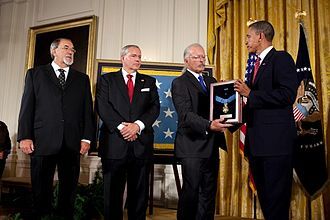
President Barack Obama presents the Medal of Honor to Etchberger’s sons on September 21, 2010
Preserving the memory of shadowy episodes like the battle of Lima 85 may not heal the wounds of the past, but it can help bring about an “honest “reckoning of the mistakes that were made and inspire reflection as to how to avoid repeating them in the future.
Sébastien Roblin holds a master’s degree in conflict resolution from Georgetown University and served as a university instructor for the Peace Corps in China. He has also worked in education, editing, and refugee resettlement in France and the United States.
This article was featured in the June “Veterans Breakfast Club” newsletter with a link to the article on 19forty-five.com. Here’s the direct link:
*****
To read more on my website about Lima Site 85, specifically about the battle between the NVA bi-planes and an American Huey, then follow this link: https://cherrieswriter.com/2013/02/12/air-story-out-of-vietnam-guest-blog/
#####
Thank you for taking the time to read this. Should you have a question or comment about this article, then scroll down to the comment section below to leave your response.
If you want to learn more about the Vietnam War and its Warriors, then subscribe to this blog and get notified by email or your feed reader every time a new story, picture, video and changes occur on this website – the button is located at the top right of this page.
I’ve also created a poll to help identify my website audience – before leaving, can you please click HERE and choose the one item that best describes you. Thank you in advance!



